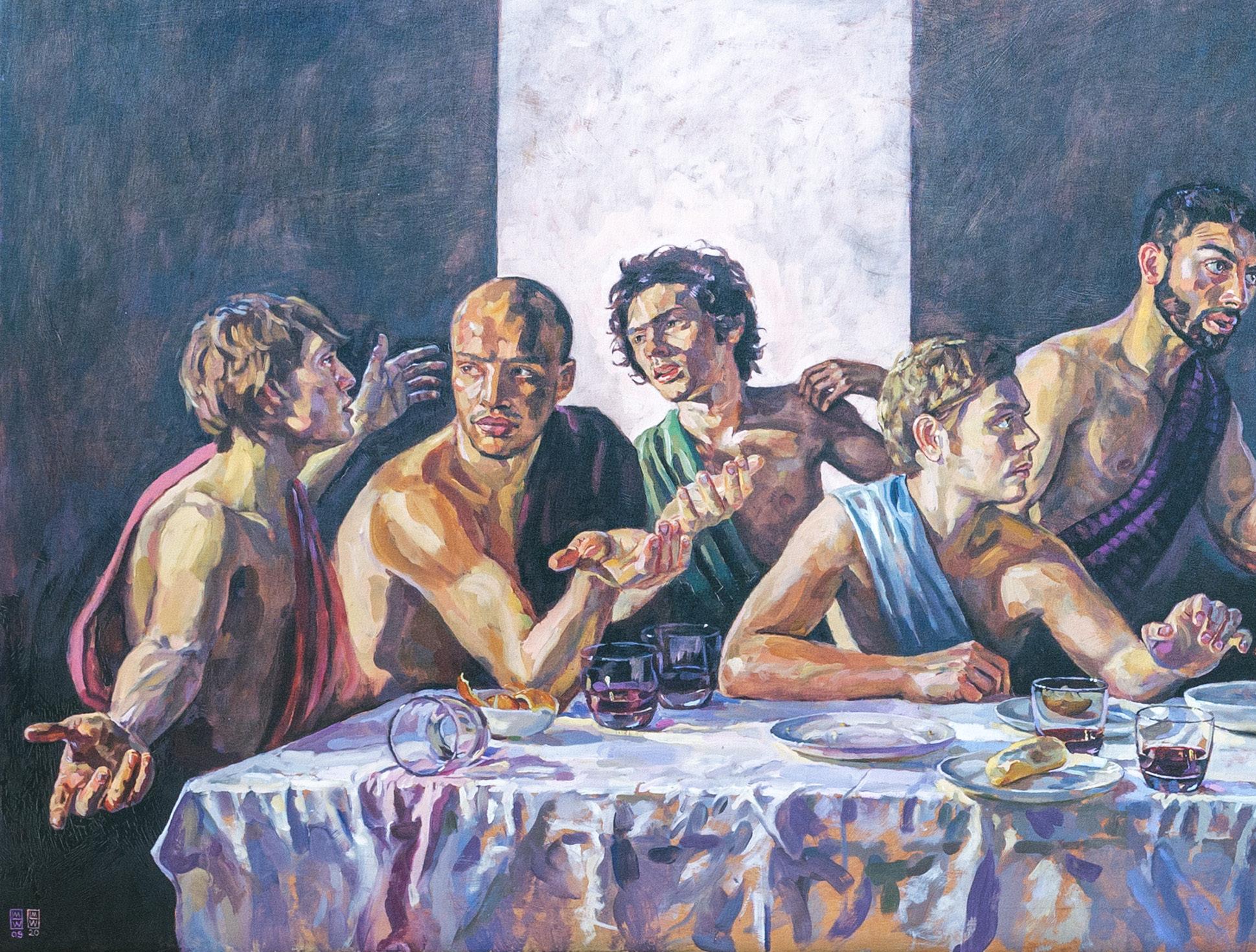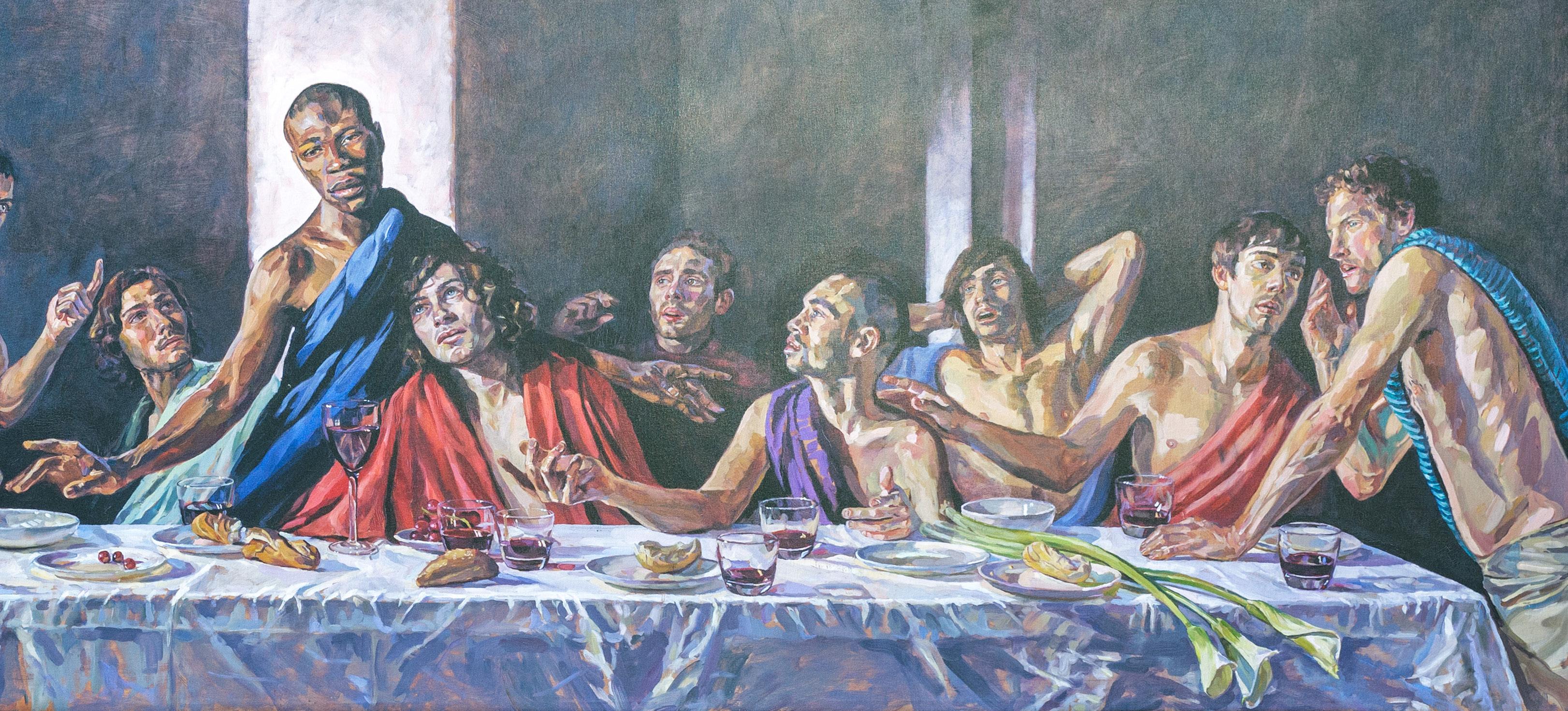

GLOBAL IMAGES OF CHRIST CHALLENGING PERCEPTIONS
25 TH SEPTEMBER – 30 TH OCTOBER 2021
A landmark exhibition of over fifty enlightening works of art, sculpture and images to challenge our perceptions as to how Jesus Christ and other people of faith are depicted by people of different ethnicity, race and colour.
Global Images of Christ
PERSONAL REFLECTION ON GLOBAL IMAGES
INTRODUCTION
WELCOME
LORNA MAY WADSWORTH
PETER EUGENE BALL
MAX KANDHOLA
THE MISSION SCHOOL CYRENE
THE SILVIA DIMITROVA ICONIC PAINTINGS – WOMEN IN THE BIBLE
METHODIST MODERN ART COLLECTION
SOLOMON RAJ
HEATHER BROWN
THE JYOTI SAHI COLLECTION
THE ROAF ICON COLLECTION
THE MADONNA COLLECTION
WINDRUSH
CHEM CHEM
THE YVONNE BELL COLLECTION
REVD CHRISTOPHER PERRINS
THE CHINESE COLLECTION
HINTON ST MARY MOSAIC THE DALIT COLLECTION
A few months ago, my daughter and my 18 months old black granddaughter went for a walk around our local mere. We met several people, all who seemed friendly and happy to chat, albeit from a distance!
“Aren’t people friendly?” I said to my daughter, “that’s because you look like them Mum.” she replied.
Her comment left me questioning, “Will they be as friendly and accepting of our little one as she grows up based upon no other information than the colour of her skin?”
How welcoming are we to those who identify as being of global majority heritage? As the Inclusion Officer for the Diocese of Chester, I pray that each of us will value and celebrate diversity. The mission of the Church is the mission of Christ, and I pray that we will live out each of the five marks of mission, two of which include:
To respond to human need by loving service and to transform unjust structures of society, to challenge violence of every kind and pursue peace and reconciliation.
Paul writes in his letter to the Galatians 3:28: “There is neither Jew nor Gentile, neither slave nor free, nor is there male and female, for you are all one in Christ Jesus.”
(Reverend Vanessa Layfield - Engagement and Inclusion Officer, Diocese of Chester)
INTRODUCTION
The tragic events in Minneapolis in May 2020 with the killing of George Floyd led to a worldwide demonstration and support of the Black Lives Movement.
The Cathedral and Diocese of Chester have responded to support our ethnic minority communities by tackling issues of racism, discrimination and prejudice as part of the Church of England’s report From Lament to Action published in April this year.
Throughout western civilisation, Christ has mainly been portrayed in a Caucasian form reflecting the way each generation has expressed its understanding of who Jesus is. The last century has witnessed a rapid change in the make-up of our culture, and the Church is being challenged to address its failure to fully support and encourage the vocation of the BAME community.
Members of ethnic communities across the region have asked how this can be addressed and Global Images of Christ – challenging perceptions seeks to highlight and promote images of both Jesus, Mary and Holy People that represent and embrace the identity of our multicultural society. This exhibition seeks to do that by bringing together more than fifty works of art from both public and private collections, including works that have been commissioned to address the absence of how Christ is seen through the stories and accounts of black and ethnic voices.
The exhibition seeks to challenge our perceptions and broaden our understanding of how God is seen in the eyes of today’s generation. In his own
earthly ministry, Jesus asked his disciples to speculate on his identity asking them “Who do you say I am?” (Matthew 16. 13-20); each generation is called to continue to help people discover Christ in themselves through inculturation. Neil McGregor (former Director of the National Gallery and British Museum) reminds us how artists have grappled to represent the Christian faith “From early Christians in the Roman catacombs to Salvador Dali, they have tackled the problem of showing Christ as both human and divine, as both victim and conqueror: one man, but the whole of humanity.”
Whilst ethnic faces of Jesus and Mary are well represented in icons from the Orthodox Church (seven examples of which are on display here) the challenge to discover images that represent Christ from a ‘non white’ contemporary perspective have proved far harder. The unveiling of Lorna May Wadsworth’s Last Supper in St Albans Cathedral last summer, drew huge press attention with Jesus portrayed as a black figure. It has spurred us on to find other representations of Holy characters that express the Christian Faith in a more inclusive way that many of us may be unfamiliar with, or challenged by.
We hope that the assembly of these works of art will help do that and allow people of all backgrounds to positively renew their identity in the living God where there is no longer Jew or Greek, slave or free, male and female (Galatians 3. 28) black or white, gay or straight … for we are all one in Christ Jesus.
(Canon Jeremy Dussek, Canon Precentor, Chester Cathedral)
WELCOME
Some Greeks came to Philip and said to him, “Sir, we wish to see Jesus,” (John 12.21). They had heard about him and were curious.
What picture do you have of Jesus? Does he have a beard? What colour are his eyes? What colour is his hair? Jesus was born in the Middle East and although we have no photographs, he was likely to have had the skin and hair colouring of that region: brown hair and brown eyes. Every culture imagines Jesus within their own context and so a variety of representations of Jesus have been painted throughout the centuries. Jesus has been painted or sculpted with features associated with people from Africa, Burma, England, Japan, Kenya, Vietnam and India to mention only a few.
The image we each have of Jesus is equally valid: in this exhibition you may find some images of Jesus and other figures in the Bible that are in accord with your imagination and others that challenge your thinking.
Please explore the images with curiosity and enjoy both the affirmation and the challenge that is offered.
Whatever your expectation, may you ‘see’ Jesus as you walk around the Cathedral.
(Canon Jane Brooke, Canon Missioner and Vice Dean, Chester Cathedral)
Lorna May Wadsworth Biographical details
Born in Sheffield, Lorna May Wadsworth now operates from her studio in East London. She rose to prominence in the contemporary art world before graduating from Falmouth College of Art, with a series of notable works, including portraits of the Right Honourable, Lord David Blunkett and the former Archbishop of Canterbury, Dr Rowan Williams.
One of her most acclaimed works, a monumental portrait of the late Baroness Margaret Thatcher, was completed from five life sittings. The resultant painting is one of the most commanding and respected formal portraits of a modern British Prime Minister.
Throughout her career, Wadsworth has continually challenged the portrait tradition and a recurrent theme throughout her work is the inversion of the gendered gaze. The canon of Western art has invariably favoured the female subject seen through the eyes of the male artist.
In her series Beautiful Boys, Wadsworth transfers the power balance, so that she holds the gaze of the male subject and places him on display for all to see.
A recent retrospective of her work, held at Graves Gallery in her home city of Sheffield, brought together her most celebrated works for the first time, including her contemporary interpretation of Leonardo’s Last Supper fresco in Santa Maria delle Grazie in Milan. Other highlights from her 25-year career include her dazzling portraits of such celebrated sitters as actors Michael Sheen, David Tennant and Sir Derek Jacobi, best-selling author Neil Gaiman, award-winning film maker Richard Curtis and another former Prime Minister, the Right Honourable Tony Blair.
(lornamaywadsworth.com)
A LAST SUPPER
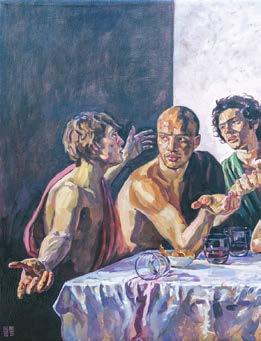
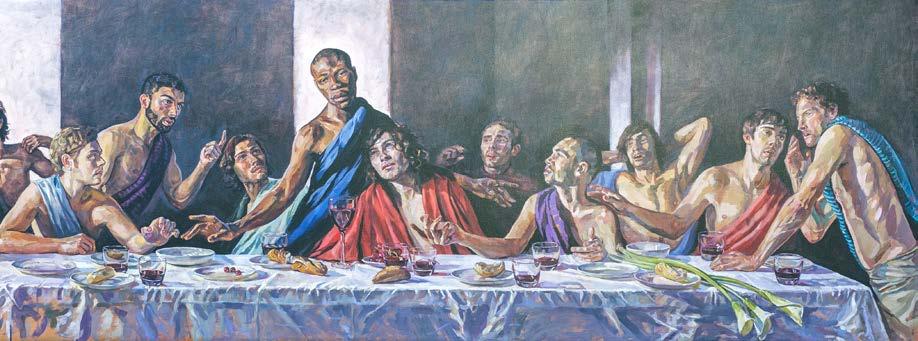
As a response to the Black Lives Matter movement, the Dean of St Albans Cathedral, Dr Jeffrey John, requested a fine art print copy of Wadsworth’s A Last Supper be hung in the Altar of the Persecuted in the North Transept. Inspired by this important gesture, Lorna decided to offer to make further high-quality print copies of the painting - purely on a cost price basis - for other churches and religious organisations.
Wadsworth forged her career and reputations with a series of celebrated representation of sitters from the worlds of politics, entertainment and literature, but it is her 2009 depiction of the last supper, with Christ as a black man, that has most recently achieved iconic status. The original version of the 12 foot long oil on aluminium reworking of Leonardo’s Last Supper currently hangs in St George’s Church in Nailsworth, Gloucestershire. It was painted entirely from life with Jesus represented by Jamaican- born fashion
A Last Supper, 2009
84.2cm
model, Tafari Hinds.
When he saw it, not long after it was painted, Dr Rowan Williams, then Archbishop of Canterbury, commented that Wadsworth’s Last Supper had “tremendous vitality, but also a really powerful tension between the agitation of some figures and the profound stillness and presence of others. All the faces repay long looking.”
In 2019, the painting made national news, when the artist discovered it had been shot whilst supervising the scanning, while in the situ behind the altar of St George’s. The damage occurred in Christ’s right side, the same place Longinus, a Roman centurion, pierced the body of Jesus with his spear as he hung from the cross.
(A Last Supper At St Albans Cathedral, Lorna May Wadsworth, 20 July 2020philipmould.com)
Lorna May Wadsworth (b. 1979 -)
Digital print on canvas
x 284cm
On loan from St Albans Cathedral
Original - oil on aluminium, 92cm x 366cm, St George’s Church, Nailsworth.
Photographer Gareth Rainsforth
Personal Reflection on A Last Supper
Reflecting on my Salvation Army childhood, I recall vividly a 1940’s portrait of ‘The Head of Jesus’ with white skin, long golden hair, and blue eyes, painted by the American Artist Warner Sallman, hanging on the wall in the Salvation Army Hall. It was in this place, at seven years old, that I looked at Jesus’ blue eyes gazing down at me, and just knew that Jesus loved me, and that I loved him.
Later, as a child protection social worker, I learnt much about the impact that early childhood experiences have on our personal values and behaviours, and as such, wondered whether asking for God’s forgiveness for the historical bias against those who identify as global majority heritage could ever lead from lament to action.
Jesus was not white as usually depicted in art, iconography, and dramatizations, and yet, whilst there is no physical description of Jesus in the Bible, there is little doubt that the historical Jesus was Jewish, Middle Eastern and brown skinned. But why is it that whilst we recognise the importance
of diverse role models in media, why do we continue to allow images of a whitewashed Jesus to dominate? Indeed, one could argue, that the White European image of Christ might serve to exacerbate the racial injustice within our society by separating our devotion to Jesus, from compassionate respect for those who look different, thereby creating a disconnection between the deep love we have for Jesus and any empathy for a Middle Eastern person. Certainly, the implications of this for any theological claim that we are made in God’s image becomes questionable. I say this because if God is imaged as white, then those who identify as global majority heritage may not feel welcome in the Church. Sadly, it is true, that historically, the ‘whitening’ of Jesus has contributed to some Christians being perpetrators of racism, and unfortunately this continues to manifest itself.
If the image of black Christ as depicted in Lorna’s painting shocks you, ask yourself why? A white image of Christ has become normalised to such an extent that we have created a misconception, a
dishonest image, which I believe is just as dishonest as a black image. I question, how much does the image matter at all? Isn’t it more important that we come to know Jesus, through God’s Holy Spirit, which has no physical image? A Holy spirit, that just like the wind, we cannot see, but we can feel its presence.
For me, the most shocking thing about this painting is, that it has sustained a bullet in the right side of Christ, almost exactly in the place where his side would have been pierced at his crucifixion. An attack on my faith, my beloved Jesus, who gave his own life as a ransom for many, including you, me, and the person who pulled the trigger.
Forgive them Lord, for they know not what they do.
(Revd Vanessa Layfield - Engagement and Inclusion Officer, Diocese of Chester)
According to Christian belief, on the evening before Jesus died, he gathered his Apostles around him for a last supper together. At the meal, which occurred during the traditional time for celebrating the Jewish feast of the Passover, he gave them the dramatic news that one of them would betray him. He also explained to them that, by breaking bread and drinking wine that he had blessed, they would be partaking of his own body and blood, and urged them to do this in remembrance of him. (Mathew 26:26-29, Mark 4:22-25, Luke 22:13-20 and 1 Corinthians 11:23-25) For many Western viewers, Leonardo da Vinci’s ‘The Last Supper’, is the standard by which all other versions are measured despite the difference of culture and society in which people live. The fact that the first event occurred in Palestine and the set up was mainly Jewish has to be a reminder to many writers who continue to ignore modern theologians who have come up with the last supper in the context of their culture and theological background. In the centuries that followed since this important
event with Jesus and His disciples, a number of theologians have come up with their own exhibition of the last supper in line with their cultural background and ethnicity. I think this is an inspired and spiritual way of bringing an inclusive creator in the lives of His followers. “So God created man in his own image, in the image of God he created him; male and female he created them. (Genesis 1:27)
This new presentation of the last supper where I am able to see none Jewish disciples surrounding Jesus has drawn me closer to a God who is neither foreign or local but a supreme being and representative of all created beings irrespective of colour, race or gender.
Colonialism might have played a key role in misleading the very first local indigenous Christians in foreign countries because it was perpetuated by people of the same ethnicity background with missionaries who were propagating the gospel of Christ. The missionaries who came along with a colonial master’s ideology did not help the
Personal Reflection on A Last Supper
ordinary Christian followers to see a Saviour who was inclusive, embracing and having no specific colour. One may even argue to say that the white missionaries did not have the capacity to preach about a God who was non white because that would not make sense. It will be my hope that the ongoing diverse depictions of the last supper continue to enlighten God’s people and create in them a mindset of a creator without colour, but an inclusive, embracing, kind, caring and loving God who is not bound by space and time.
“There is neither Jew nor Greek, there is neither bond nor free, there is neither male nor female: for ye are all one in Christ Jesus.”
(Galatians 3:28)
(Canon Lameck Mutate, Chair of Diocesan and Minority Ethnic Forum, Rector of Tattenhall, Handley and Burwardsley)
Lorna May Wadsworth
The Kiss of Betrayal
2015
In The Kiss of Betrayal, Wadsworth takes the iconic moment of Judas’s treachery in the Garden of Gethsemane and re-sets it in a startlingly contemporary context. By isolating the figures in a vast cinematic close-up, the piece is electric with ambiguity. Referencing icon painters of the past, Wadsworth’s sculptural figures are set against 24 carat gold, but rather than left a solid gold background the edges of The Kiss of Betrayal are lined with shadowy charcoal, referencing Judas’s treachery. The two heads, each figured like classical sculptures, are separated by a lightning bolt of suspense, their angles reminiscent of glamorous silver screen kisses from old Hollywood. Christ’s eyes gaze out heavenwards, the catch-light picked out in silvery platinum.
The piece sears into the crisis of homosexuality within the modern church. It is at once entirely rooted in biblical orthodoxy and the art historical canon, but in stripping all the extraneous details away, this painting directly challenges the homophobic unease inherent in many parts of the modern church. “I wanted it to be a little ambiguous, like you’re not sure if Judas is about to ‘nut him’ or kiss him”, Wadsworth explains. “By making such a cinematic scale close up, removing all other allusions to the plot and the context, to perhaps engage with and confront some Christians’ troubled acceptance of gay marriage, and I guess gay people full stop. I like to introduce a duality when I tackle religious themes, to make people really think about their beliefs and prejudices.”
(Dr Sophie Kelly - Lorna May Wadsworth: A Retrospective, 2015)
THE KISS OF BETRAYAL
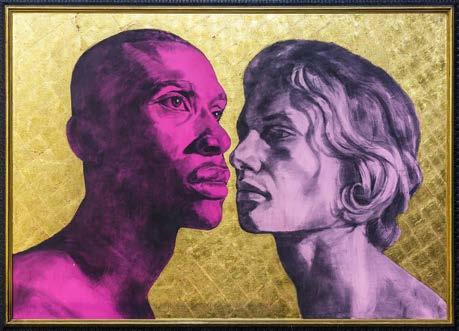
Lorna May Wadsworth (b. 1979 -)
The Kiss of Betrayal, 2015 Acrylic, two shades of 23 carat gold and charcoal on canvas 120cm x 180cm (not including frame) On loan from the artist
Photographer Gareth Rainsforth
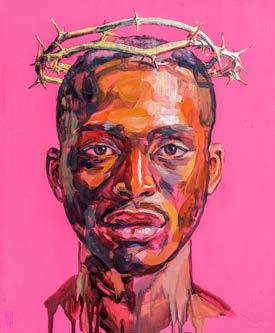
Lorna May Wadsworth (b. 1979 -)
Pink Christ, 2011
Acrylic, two shades of 23 carat gold and oil on panel
40cm x 32.5cm
On loan from the artist
Photographer Gareth Rainsforth
Christ’s arresting stare is at once powerful and quietly moving in this remarkable reimagining of one of the pivotal moments in the crucifixion narrative. In Pink Christ, we meet Jesus in the very midst of his torments: betrayed, delivered to the authorities and condemned to death, the torture he endures at the hands of Pontius Pilate’s soldiers includes a mock-crowning with a woven wreath of thorns. This biblical event formed the basis of a popular devotional image known as Ecce Homo, or ‘Behold the Man’, the words said to have been uttered by Pilate when he presented the scourged Christ before a hostile crowd of onlookers. While some imaginings of this scene show Jesus amidst his tormentors, Wadsworth’s rendering, in a manner more reminiscent of the Baroque Ecce Homo paintings of Guido Reni, abstracts Christ’s head, presenting a stark, intimate window into this heightened moment of pain and suffering. In Pink Christ Wadsworth pushes the concept of abstraction to the fore, utilising pink to flood the background of the painting, removing Christ from his crowd of tormentors and placing him instead in a sea of fluorescent paint. Perhaps most striking of all is Christ’s expression, inscrutable as much as it is powerful.
Unlike the Jesus of A Last Supper, this Christ is not passively serene in the face of anguish and torment. That he feels deeply is conveyed in the
Lorna May Wadsworth Pink Christ
directness of his gaze, the rigidness of his hardset jaw; yet how this Jesus feels as he is mocked and left debased is indecipherable. Pink Christ leaves us guessing.
Colour is an important motif throughout Pink Christ. “Fluorescent pink started to seep into my work as a kind of punk variation on the warm red boule you traditionally use underneath gilded gold leaf”, Wadsworth explains. “I have also explored using fluorescent colours in place of gold as a modern interpretation of an icon painting – the colour glows and silhouettes the subject somewhat, like gold leaf does.” Though gold does not feature as a traditional background, it is wrought instead, in two shades of 23 carat gold, into the crown hovering like a halo over Christ’s head. As a masterful play on traditional materials, technique and symbolism, Pink Christ is a truly modern icon.
(Dr Sophie Kelly - Lorna May Wadsworth: A Retrospective, 2015)
2011
This has proved to be one of the most popular pieces in the exhibition, strikingly situated at the entrance to the Erasmus chapel and visible from the north aisle across the quire. It is one of Lorna May’s most recent works and one of the most arresting. The vivid cobalt blue and gold of the circular image immediately captures the viewer, so that our eye is drawn in to the fixed intensity of Christ’s gaze. He stares out of the image and engages with us directly. He is a powerful black Christ and not merely a ‘Man of Sorrows’. His gold crown of thorns has transmuted into a shining halo. And yet he is Everyman.
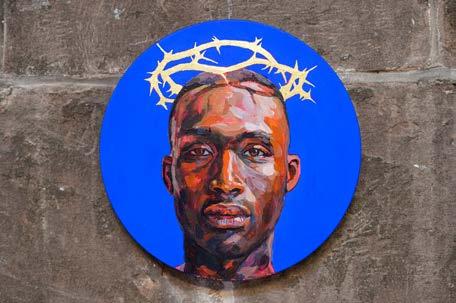
BLUE CHRIST
(Maggie Jackson, Honorary Research Fellow, University of Chester)
Lorna May Wadsworth (b.1979 -) Blue Christ, 2021 Acrylic, two shades of 23 carat gold and oil on plaster 25cm diameter On loan from the artist
Photographer Gareth Rainsforth
Lorna May Wadsworth Blue Christ 2021
Peter Eugene Ball was born in Coventry in 1943. He attended Coventry College of Art and in 1961 joined the Marjorie Parr Gallery on the King’s Road in London where he had his first one-man show. His sculpture at that time was diverse and eclectic with no religious connotation. He worked with driftwood and other found objects such as railway sleepers, bells and ropes to create figures which often had an historical, mythical or literary origin. Thus began a succession of one-man shows and joint exhibitions over the next few years alongside such artists as John Piper, Winifred Nicholson and John Hitchens. During this period Peter also had a number of different jobs to maintain an income but in 1968 he decided to make sculpture his full-time occupation.
His first religious piece, a simple crucifix, was bought in 1974 by a priest at Westminster Cathedral and four years later he obtained his very first church commission: a memorial crucifix at Preston-on-Stour in Warwickshire. However, it wasn’t until 1986, when Birmingham Cathedral commissioned a crucifix and altar pieces, that regular church work became an integral part of his life and over the next few years he began to place major pieces in some of the country’s great cathedrals as well as smaller figures in various
Peter Eugene Ball Biographical details
parish churches. During this time he continued to exhibit and sell his sculpture, both religious and secular, in galleries and at exhibitions across the UK, Europe and America.
To date Peter’s sculpture has appeared in over 40 exhibitions and he now produces a major one-man show once every two years, which usually takes place in a cathedral setting and brings together some of his transcendent religious figures along with quirky, often witty secular pieces, both of which define his work.
His career now spans more than 50 years and Peter currently has more than 90 works of art in churches and cathedrals throughout the UK –almost certainly more than any other living artist. He lives in Newark in Nottinghamshire with his wife, Jane, where he works from his garden studio and continues to undertake regular commissions, both religious and secular.
Pilgrim
Date Unknown
Pilgrim is a wonderful black figure. As he is still and reflects – God’s light transfigures his face with love and grace. How often is our dignity and true self hidden and yet God comes to bring him to light – a technique that Peter Eugene Ball uses in some of this works. I pray that the exhibition may be an opportunity to bring to light images of Christ represented through some of the different cultures represented here.
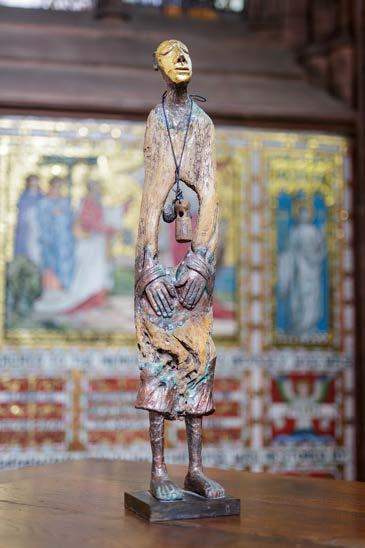
PILGRIM
(Canon Jeremy Dussek, Canon Precentor, Chester Cathedral)
Peter Eugene Ball
Peter Eugene Ball (b.1943- ) Pilgrim, Date Unknown Carved wood with gold leaf Height 79cm Loaned by Revd James Buxton to Canon Jeremy at Chester Cathedral
Photographer Chris Bebbington
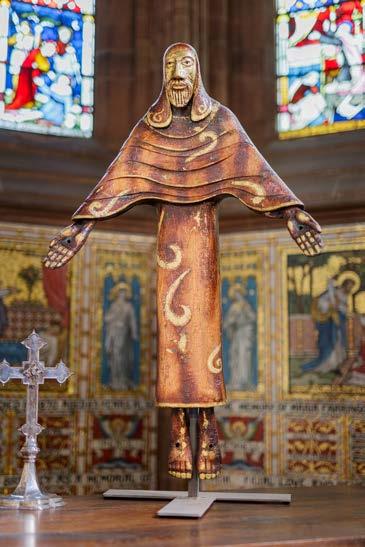
When researching for works of art for this exhibition, Peter Eugene Ball’s figures were a natural choice to borrow. He has created several Black Madonna and Child but sadly these are all in private collections abroad. Derby Cathedral’s Christus Rex can be seen as a wonderful depiction of a Black representation of Jesus. On enquiring about whether it could be loaned, the reply was that it had been knocked over and its left arm has been broken. How often have people of ethnic minorities been pushed aside to the ground. I’m pleased to say that Peter Eugene Ball has kindly come in to restore Christus and here he is resurrected for us to see. I hope this exhibition will help restore confidence in finding their rightful worth in discovering their image reflecting that of Christ.
(Canon Jeremy Dussek, Canon Precentor, Chester Cathedral)
Height
Photographer Chris Bebbington
Peter Eugene Ball Christus 2000
Peter Eugene Ball (b.1943- ) Christus, 2000
Carved wood with copper and gold leaf
115cm
Loaned by Derby Cathedral
Max Kandhola
Biographical details
Max Kandhola is a British Punjabi Sikh, a renowned fine art photographer and a Principal Lecturer at Nottingham Trent University, teaching on theory and practice. He is represented by PhotoInk http://www.photoink.net/ in India and manages his studio from Birmingham England. He was twice the recipient of the prestigious Light Work Artist in Residency at Syracuse New York. His work has been exhibited nationally and internationally and published 4 monographs. The photographic work is positioned within the context of Black and Asian identity and histories. Kandhola’s photography is held in major public and private collections in England, Europe, America and India, including, The Deutsche Bank Collection and Government Art Collection UK. His most recent exhibitions include The Last Seven Words of Christ in collaboration with St Marks Church In The Bowery, New York, Feb- March 2021 and 2020 and ‘u fucking paki’ FotoFest 2018 Biennial: India/Contemporary Photographic and New Media Art, Houston, Texas, United States, 10 March - 22 April 2018. Max is a member of FACE https://www.weareface.uk/members to challenge the lack of Black and Brown academics in the system, which directly impacts the experience of all young creatives but especially Black and Brown students. FACE demands acknowledgement of the contribution of Black culture and creativity, to history, society and to fashion.
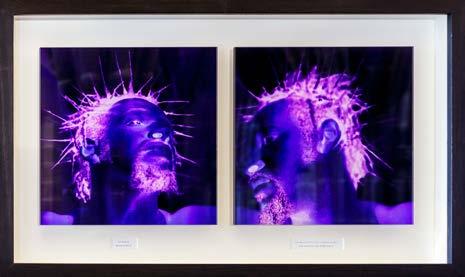
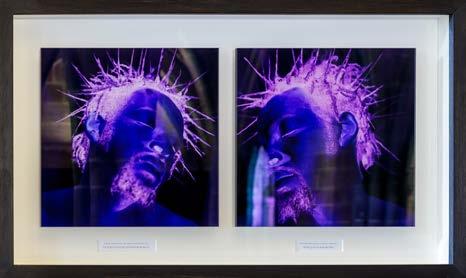
The Last Seven Words of Christ 2020
‘The Christ figure is black, with dreads, and a crown of thorns, which blend into the hair.’ There are multiple layers of interpretation when considering this work. The historical significance of Day’s original photographs his own sexuality, the rise of the black theology movement in Britain in the late twentieth century, and in Kandhola’s reinterpretation of work in relation to the representation of individuals of African descent, or more specifically non-European descent, in what Kandhola refers to as ‘the dilution of history through literature, and paintings within Western culture.’
Max Kandhola’s “The Last Seven Words of Christ” considers contemporary photographic art in the context of photographic history, while raising issues of authorship, de-colonization, and the ownership of cultural history. Kandhola has produced an elaborately staged contemporary response to F. Holland Day’s iconic exercise in self-portraiture “The Seven Words” (1898) in which the photographer portrays himself as the dying Christ in a series of beautifully crafted platinum print. Day was a leading light of the photographic movement known as Pictorialism, whose proponents aimed to establish the photograph as art, by espousing an object-centric, often highly manipulated image with a painterly surface. This powerfully influential style is primarily associated with white, upper-class men, as until recently, has been the case with the history of photography. By reimagining Day’s somber Christ as a person of color rendered in a vibrant contemporary style, Kandhola forces us to consider both Day’s work and the world it was shaped by in terms of today.
THE LAST SEVEN WORDS OF CHRIST
Max Kandhola
Max Kandhola
The Last Seven Words of Christ 2020
‘the face of ‘Christ’ now appears to melt into the unfathomable depths of a deep purple. Light seems to leak from his skull; through his nostrils, hair, ears, and the crack between his eyelids, turning these edge-lands of the body into spaces of electric energy, where light and dark merge and flow into each other. In these images the solid is transfigured, dissolving into a nebulous sea of colour’.
Kandhola has intentionally set out to challenge both the idea of a high-art photographic canon and the complex baggage of Christianity in a world that is increasingly multi-cultural. In addition to the work itself, the artist has undertaken exhibitions in a wide variety of secular and sacred spaces, allowing the image content to interact with space, site, architecture and history. Kandhola is fully familiar with 19th and 20th century histories of photography. His response to Day’s iconic series is thoughtful and appropriate. Kandhola is also aware of the much longer history of representations of Christ in painting. Recent photographic art is often disconnected from the specialized history of the medium, and religious subjects are unusual. By challenging these common aspects of contemporary practice, Kandhola places his work in several longer, broader contexts, and himself, as a British Punjabi Sikh, in a unique position to comment on Western culture.
(Alison Nordström,
PhD, Independent Scholar/Curator of Photographs Museum Associate, Peabody Museum, Harvard University & Visiting Scholar, Graduate Department of Photography and Integrated Media, Lesley University)
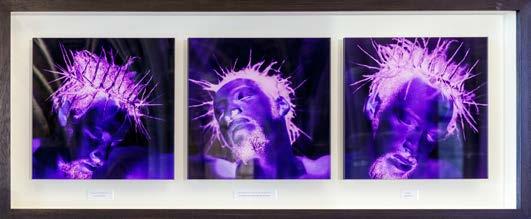
‘The artist portrays the body as being still, but maintains traces of precedent moving, active choices and working towards this theatrical pose, creating a critical commentary on practices of fragmentation, selective seeing, and restrictive cultural processes. However, the body is restored as a source of knowledge and self-perception – the emblematic crown of thorns is an extension of the body, a symbol of expanding agency and reclaiming authority over the relationship between body and space. The instruments of controlling black masculinity are challenged, together with the pervasive ways of appropriating black male bodies in Western visual culture.
The imagery featured in Christianity produces a shocking effect, leading to a visual bypass of symbols and signs, while materializing critical interrogations and protest’.
Max Kandhola (b.1964 - )
The Last Seven Words of Christ, 2020 7 di-bond photographs (mounted onto aluminium and encased within a di-bond) 25.5cm x 25.5cm (x 7 images) Loaned by the artist
Photographer Gareth Rainsforth
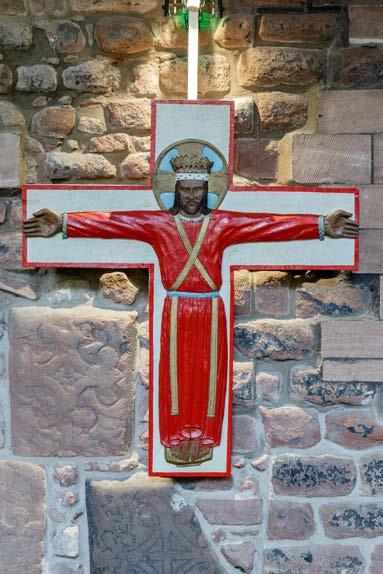
The Mission School Cyrene Black Christ Crucified, 1957
Carved and painted wood
125cm x 110cm
Loaned by Crist y Brenin Church, Parish/Ministry Area: Bro Cadwaladr Diocese: Bangor
Photographer Gareth Rainsforth
The Mission School Cyrene Black Christ Crucified 1957
The Wooden Crucifix depicting a Black Christ, was carved in Africa and brought over from the mission school at Cyrene, which is in modern day Libya.
The vicar at the time, the Rev G. Emyr Lewis had connections with the mission school and visited Cyrene on numerous occasions.
He ordered the crucifix while he was there on one of his visits, without giving much thought to the colours.
The fact that the Christ is black, has always evoked great discussion, as most of the locals at the time of its arrival in Malltraeth, were used to seeing Christ depicted as white. Some locally, thought this depiction was a much truer representation, others were unsure.
It is believed, although Rev Lewis ordered the crucifix, a local benefactor called Mrs Stone financed the venture and presented it to the church, where it hangs today.
(Mrs Glenys Smallwood, Licensed Reader Emeritus)
BLACK CHRIST CRUCIFIED
Silvia Dimitrova
Biographical details
Silvia was born in Pleven, Bulgaria in 1970 and won a place at the School of Applied Arts at Troyan at the age of 13. She graduated in 1989 and then studied icon painting in Sofia under the tuition of Georgi Tchouchev and was invited to exhibit her work in Alexander Nevsky Cathedral, Sofia, amongst the elite group of icon painters.
She held a successful one-woman exhibition in Paris, in the Cultural Centre Edmond Rostand, Rueil-Malmaison in 1997. In the spring of 1999 she was commissioned by Downside Abbey to paint the Icon of St Benedict. At the beginning of 2000 Silvia worked as an artist-in-residence at Wells Cathedral with a commission to paint the Fourteen Stations of the Cross as a project for the Millennium. During this time she was also nominated and shortlisted for the European Women of Achievements Awards 2000 for contributions to the Arts. Since then Sylvia has been working on both private and public commissions including St Paul’s Cathedral, London and Hertford College, Oxford, Bishop’s Palace, Wells and St Peter’s, Eaton Square.
She works in the traditional technique of icon painting – egg tempera on wood, and her work covers the whole spectrum of traditional Bulgarian icons and original work.
(silviadimitrova.co.uk)
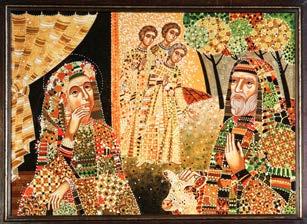
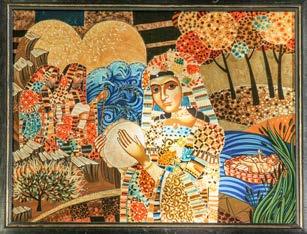
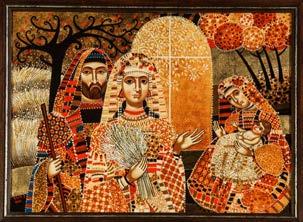
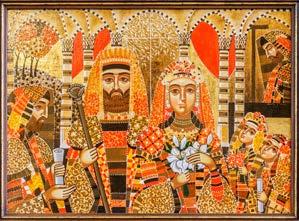

Women in the Bible – The Rt Revd Dr Graham Kings
‘Choose a subject, and I will commission Silvia Dimitrova to paint it for your 50th birthday’. My wife, Ali, offered me this wonderful gift in 2003, when I was Vicar of Islington.
‘The moment Mary Magdalene hears Jesus call her by name, on Easter morning’, I replied. I knew there had been many paintings set a few seconds later, concerning (Noli me tangere – don’t touch me), but had never seen one of the instant her face, and her faith, came alive.
Silvia is a Bulgarian Orthodox icon writer based in Bath, whose exhibition we had arranged in the crypt of St Mary’s Church, earlier that year. I later wrote a poem expounding John 20: 11-18 and her iconic painting.
When I became Bishop of Sherborne, in 2009, the churchwardens said the church would like to give us a farewell present and we suggested a contribution towards another painting. We chose Lydia, a trader in purple goods, and, during my consecration retreat, I wrote a poem on Acts 16: 6-15 and Silvia’s painting.
It was in discussing this second commission with Silvia that our project of seven ‘Women in the Bible’ emerged.
I had seen Zurburan’s paintings of the 12 Sons of Jacob in Auckland Castle and had wondered about a series of biblical women.
For my 60th birthday, 2013, we chose ‘Priscilla’ and I wrote on Acts 18: 1-4, 24-28 and Romans 16: 3-4.
‘Sarah’, whose face reflects my mother’s face, was painted soon after I became Mission Theologian in the Anglican Communion, in 2015, and my inaugural lecture for the project, at Durham, ‘Sarah the Mother of Mission’, included the poem as part of the exposition of Genesis 18: 1-15.
‘Miriam’ was painted in 2017, with the face of our middle daughter, Miriam. The poem was written during a quiet day at the Royal Foundation of St Katherine, East London. ‘Ruth’ was finished in 2019, resonating with the face of our eldest daughter, Rosalind and the poem was written during another quiet day.
WOMEN IN THE BIBLE SERIES
Silvia Dimitrova Women in the Bible Series
‘Esther’ completed the series of seven in 2020, with the face of our youngest daughter, Katie, whose middle name is Esther. The poem was written again at St Katherine’s.
In February 2019, over lunch at St Chad’s College, Durham, Margaret Masson, the Principal, introduced me to Tristan Latchford, the Director of Music, and a young composer. Tristan agreed to write seven anthems on the seven poems and paintings and, astonishingly, completed them all by the end of 2020. He is now studying for his PhD at the Peabody Institute of John Hopkins University.
The 17 year old project of Women in the Bible interweaves three forms of art – painting, poetry and music – all expounding the nourishing words of the Holy Scriptures.
(The Rt Revd Dr Graham Kings)
Dr Kings, in retirement in Cambridge, is Hon Assistant Bishop in the Diocese of Ely and Research Associate at the Cambridge Centre for Christianity Worldwide, which he founded in 1996. He trained for ordination at Ridley Hall (1978-80) and was the Henry Martyn Lecturer in Mission Studies in the Cambridge Theological Federation (1992-2000)’
The book of poems Nourishing Connections written over 35 years was published by Canterbury Press in 2020.
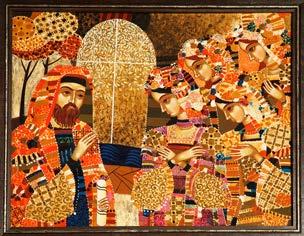
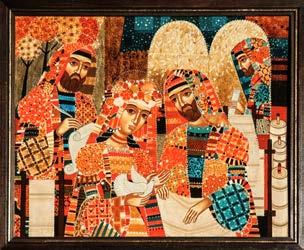
Silvia Dimitrova (b.1970 - ) Sarah, 2015
Egg tempera on wood 61cm x 78cm
Loaned by The Rt Revd Dr Graham Kings and Mrs Alison Kings
Silvia Dimitrova (b.1970 - ) Miriam, 2017
Egg tempera on wood 65cm x 79cm
Loaned by The Rt Revd Dr Graham Kings and Mrs Alison Kings
Silvia Dimitrova (b.1970 - ) Ruth, 2019
Egg tempera on wood 62cm x 79cm
Loaned by The Rt Revd Dr Graham Kings and Mrs Alison Kings
Silvia Dimitrova (b.1970 - ) Esther, 2020
Egg tempera on wood 61cm x 78cm
Loaned by The Rt Revd Dr Graham Kings and Mrs Alison Kings
Silvia Dimitrova (b.1970 - ) Magdalene, 2003
Egg tempera on wood 57cm x 67cm
Loaned by The Rt Revd Dr Graham Kings and Mrs Alison Kings
Silvia Dimitrova (b.1970 - ) Lydia, 2009
Egg tempera on wood 57cm x 67cm
Loaned by The Rt Revd Dr Graham Kings and Mrs Alison Kings
Silvia Dimitrova (b.1970 - ) Priscilla, 2013
Egg tempera on wood 58cm x 68cm
Loaned by The Rt Revd Dr Graham Kings and Mrs Alison Kings
Photographer
Chris Bebbington / Gareth Rainsforth
John Muafangejo
Biographical details
John Muafangejo was born in Lo Mghadi in Southern Angola in 1943. After the death of his father in 1956 he moved to live in Namibia where he was formally educated at St Mary’s Anglican Mission. From there and in recognition of his artistic talent and interest he went, in 1964, to study at Rorke’s Drift Art School in Natal. His medium of choice was the linocut and he produced a wealth of beautifully descriptive visual narratives. In 1987 he had a very successful one man exhibition at the Festival Hall in London, sadly he died on his return to Namibia. He is probably best remembered in the UK for the 1988 Wembley Concerts celebrating Nelson Mandela’s 70th birthday when large images of his prints were used on the canvases that formed the backdrop to the event.
(Seeing the Spiritual: A Guide to the Methodist Modern Art Collection, 2018)
John Muafangejo (1943-1987)
Judas Iscariot betrayed our Lord Jesus for R.3.0, 1972
Linocut – signed print no 37 of 100 34cm x 45cm
Loaned by Trustees of the Methodist Modern Art Collection
John Muafangejo
Judas Iscariot betrayed our Lord Jesus for R.3.00 1972
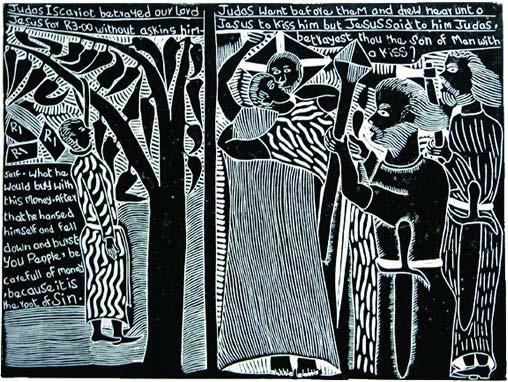
This work is divided into two parts. On the right a cleanshaven Judas is shown embracing Jesus while two bearded figures, with weapons in their hands and sheathed swords, look on. They must be part of the high Priest’s entourage. On the left Judas is shown hanging from a tree: three rand notes, the price of betrayal, can be seen below the foliage.
(Seeing the Spiritual - A Guide to the Methodist Modern Art Collection, 2018)
Photographs by permission of the Methodist Modern Art Collection
Mark Cazalet
Biographical details
Mark Cazalet is a contemporary artist based in London and Suffolk, UK. He studied at Chelsea School of Art and then Falmouth School of Art. Immediately after graduating he was awarded the French government’s National studentship award to study in France. He studied at L’Ecole-des-Beaux-Arts Paris in the studio of Christian Boltanski. Simultaneously to this scholarship he was awarded a year at the Cite-des-Arts studio complex in the Marais. After a year back in London he went to M.S. University Baroda for an eighteen month Association of Commonwealth Universities Scholarship to study under Professor Fulham Mohamed Sheikh. Since his return to the UK he has held a number of residencies and in 2012 and 2013 was artist in residence twice at The Anni and Josef Albers Foundation in Connecticut, America.
Mark is a Senior Member of Faculty at The Royal Drawing School and teaches at West Dean College, the Edward James Foundation, Sussex and the University of the West of England. He is a Trustee of City and Guilds London Art School.
(markcazalet.co.uk)
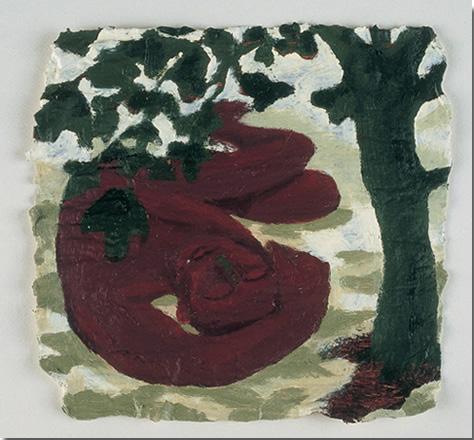
Cazalet portrays Nathaniel lying down on the ground under the fig tree, prior to his calling by Philip. He is shaded by the foliage and lies apparently naked. The ground is sketched in beneath him, with the dappled shadow of the fig tree. The tree is not botanically accurate but fits the artist’s purpose in portraying the fig tree as an image of fruitfulness and consistency.
The artist has tried not only to capture the nub of the story, particularly Nathaniel’s bizarre response to Jesus’ comment, but also to suggest that there was something unusual about the narrative. Cazalet suggests that Nathaniel knew that Jesus had seen him in his entirety, “through all the trappings, nothing was hidden, all was exposed and acknowledged”. In the simplicity of the composition (a figure, a few marks to indicate the ground and few more to indicate the tree), Cazalet has captured the simplicity of the story, the “metaphysical moment when every part of Nathaniel was ‘seen’ by Christ.”
18cm x 18cm
Mark Cazalet
Nathaniel (asleep under the fig tree) 1993
The story of Jesus’ encounter with Nathaniel is an unusual subject for a painting. The artist knows of no other versions and there are no well-known paintings of the subject by the Old Masters. Cazalet was simply intrigued by the story. The modelling of the figure, which is coloured an unrealistic deep reddy brown, is very sculptural and three-dimensional, drawing on the impact of ‘primitive’ or ‘tribal’ art (African, Pacific Island, American and Inuit) on twentieth century art. Early Epstein, Gill, Moore, Barbara Hepworth and Eric Dobson sculptures are particularly relevant in this respect.
(Seeing the Spiritual – A Guide to the Methodist Modern Art Collection, 2018)
(ASLEEP UNDER THE FIG TREE)
Mark Cazalet (b. 1964 - )
Oil on paper
Loaned by Trustees of the Methodist Modern Art Collection
Photographs by permission of the Methodist Modern Art Collection © TMCP
Mark Cazalet Fool of God
(Christ in the garden)
1993
Cazalet portrays Jesus at prayer, leaning against a rock in the spare landscape. He does not clutter the picture or heighten the tension within it by including the angel or the other disciples, or by seeking to convey the agony of Jesus physically in any way. The title of the painting refers to the idea of ‘Holy Fools’, familiar to us particularly from Russian literature and history as those who “set God’s will above worldly wisdom, even to the point of martyrdom”.
The figure of Jesus is portrayed with a single serpentine brush stroke, which captures the bend in his back over the convenient rock, and the reddy-brown colour contrasts in tone and hue with the greens and olives of the landscape with its tree, scrub, rocks and path. The artist contrasts the figure of Jesus with that of Isaac, bound by his father before being sacrificed, held against his will but later released; here Jesus is held of his own free will by his mission on earth, although he is technically free to run away. Cazalet has sought to capture the “moment of (Christ’s) most profound incarnation, fully in dread at the fate he knew would come as a man, yet faithful and obedient in his divine fulfilment of the sacrifice.
(Seeing the Spiritual - A Guide to the Methodist Modern Art Collection, 2018)
FOOL OF GOD
(CHRIST IN THE GARDEN)
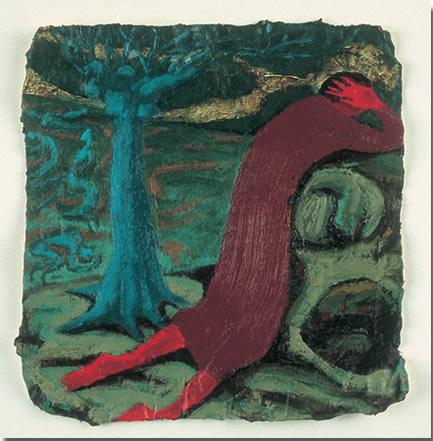
Mark Cazalet (b. 1964 - ) Oil on paper 18cm x 18cm Loaned by Trustees of the Methodist Modern Art Collection
Biographical details
Born in 1894 in Bowrai, New South Wales, de Maistre studied at the Royal Art Society of New South Wales from 1913-16 before attending the Sydney Art School.
‘Little known during his life (the catalogue for his 1960 retrospective drew attention to his unfamiliarity among the general public and the scant attention he received from the art world as well), de Maistre is perhaps largely forgotten today. Yet he is an important figure in the twentieth century art history of his native Australia, and also in Britain) he lived in England from 1938 until his death in 1968). Initially as interested in music as art (he studied both), some of his early work was concerned with the relationship between music and art and he developed an interest in colour which has been compared to a musical approach and which continued to inform his work throughout his life.
He developed a very personal style, combining elements from cubism and traditional realism and can be regarded as one of the century’s major religious artists, successfully tackling the difficult task of painting religious works which are contemporary in idiom but which can stand alongside the masterpieces of the past that so colour and influence our expectations’.
(Seeing the Spiritual - A Guide to the Methodist Modern Art Collection, 2018)
Roy de Maistre
Roy de Maistre
Noli me Tangere (Touch me not)
1952-58
The figure of Jesus, facing us, towers over the kneeling Mary Magdalene, who has her back towards us. It is still early morning and the sky is red with sunrise. The warm red-brown colour of both the landscape and Mary contrasts with the cool blues, white and greys of Jesus and the rocky garden. The mouth of the tomb, in a reddish stone or brick, is visible on the left.
In addition to this painting, there are two or three other versions of Noli me Tangere, the largest and earliest dating from 1950-51, painted for the Arts Council’s Festival of Britain exhibition of ’60 Painters for 51’, with the others (as well as the Methodist work) being much smaller.
(Seeing the Spiritual – A Guide to the Methodist Modern Art Collection, 2018)
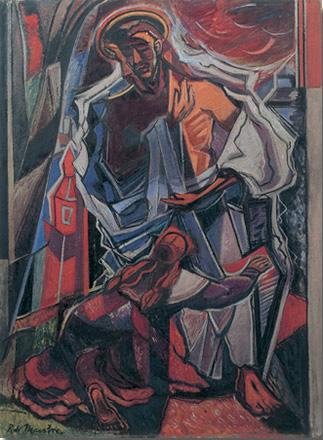
NOLI ME TANGERE
(TOUCH ME NOT)
Roy de Maistre (1894-1968)
Noli me tangere (Touch me not), 1952-58 Oil on Canvas
95cm x 67cm
Loaned by Trustees of the Methodist Modern Art Collection
Photographs by permission of the Methodist Modern Art Collection © TMCP
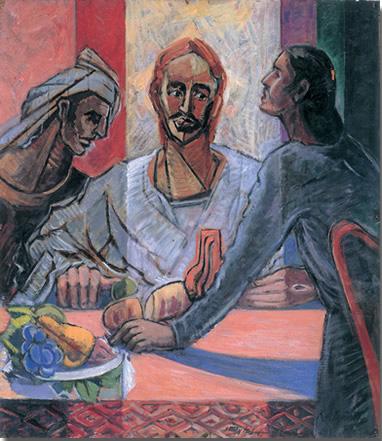
De Maistre shows Jesus, in a white gown, positioned centrally at the table with one of his disciples on the left and the other sitting at the side of the table. Jesus is breaking the bread and has an apple (or some other green fruit) in front of him. More fruit (including a pear and black grapes) lie on a plate or bowl on the table. The disciples are portrayed just as recognition dawns on them that their companion is Jesus. The wounds, the nail hole in Jesus’ left hand and the wound of the spear in his side are clearly visible and confirm their realisation.
In 1958, De Maistre was one of several artists approached by St Edmond Hall in Oxford to paint a Supper at Emmaus for the college chapel. Ceri Richards was eventually selected, and the Methodist Collection includes a study of this painting…
(Seeing the Spiritual – A Guide to the Methodist Modern Art Collection, 2018)
THE SUPPER AT EMMAUS
Roy de Maistre
The Supper at Emmaus 1958
Roy de Maistre (1894-1968)
The Supper at Emmaus, 1958
Oil on Canvas
60cm x 50cm
Loaned by Trustees of the Methodist Modern Art Collection
Photographs by permission of the Methodist Modern Art Collection © TMCP
Biographical details
Sadao Watanabe was born in Tokyo in 1913 and he died there in 1996. Watanabe’s father died when he was 10 years old. He left school early, and became an apprentice in a dyer’s shop. Through a neighbour, he was introduced to Christianity, and was baptized at the age of 17. After working for some years with a textile printer designing kimono fabrics, he came across Serizawa Keisuke, from whom he learnt the ancient Okinawan technique of stencildying using hand-made paper and natural pigments…
In 1958, he began to make an impact in the US by winning first prize at the Modern Japanese Print Exhibition in New York City. His work soon became popular, and was acquired by leading museums. Despite his growing international reputation, Watanabe’s aim was to reach his fellow countrymen with the Christian message. Not only is his work executed in traditional Japanese medium, but his biblical themes are depicted in a Japanese setting. He liked his prints to hang in ordinary places where people gather together, “because it was to them that Jesus brought the gospel”. This, together with the use of natural material, is characteristic of mingei: art for the people and by the people…
(Seeing the Spiritual: A Guide to the Methodist Modern Art Collection, 2018)
Sadao Watanabe
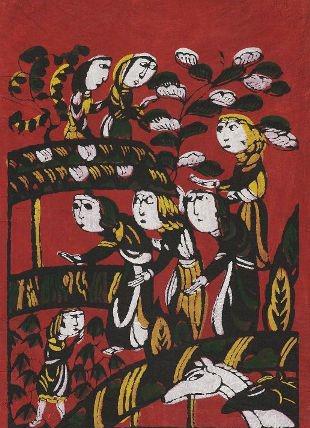
People visit the Stable, 1962
Stencil: natural pigments and ink on paper. Print 48/50
80cm x 59cm
Loaned
“When the angels had left them and gone into heaven, the shepherds said to one another, ‘Let us go now to Bethlehem and see this thing that has taken place, which the Lord has made known to us.’ So they went with haste and found Mary and Joseph, and the child lying in the manger.”
Luke 2:15-16
Watanabe completed several series of nativity prints. In this picture, people gather to see the baby, expressing, perhaps, serious purpose rather than great excitement. It is not clear if they are shepherds or other members of the local community. For us, they represent ordinary Christians coming to show homage to the Christ Child.
(Seeing the Spiritual: A Guide to the Methodist Modern Art Collection, 2018)
PEOPLE VISIT THE STABLE
Sadao Watanabe People visit the Stable 1962
Sadao Watanabe (1913 – 1996)
by Trustees of the Methodist Modern Art Collection
Photographs by permission of the Methodist Modern Art Collection © TMCP
Dr P. Solomon Raj
Biographical details
Solomon Raj was a Lutheran theologian and artist from India. Born in 1921, he became a school teacher, then studied theology at Gurukul, Madras, served as a minister and as a student chaplain and after that fulfilled a wide range of positions in India, at Selly Oak, Birmingham (UK) and other countries before settling down again in his own country. In the meantime he published his PhD dissertation in Birmingham and was active in the Asian Christian Arts Association. For a number of years he was the spiritual father of the St Luke’s Lalitkala Ashram in Vijayawada, Andra Padesh. In the 1950s he discovered his gift as an artist, first specialising in linocuts and wood block printing. Later he also made batiks andthough to a lesser extent – acrylic paintings. He discovered the possibilities of using visual art as a means of explaining the biblical narratives and propagating the Gospel. Most of the art works which he published in separate booklets and books are accompanied by brief poetical meditations.
(Artway Visual Meditation, February 10, 2013)
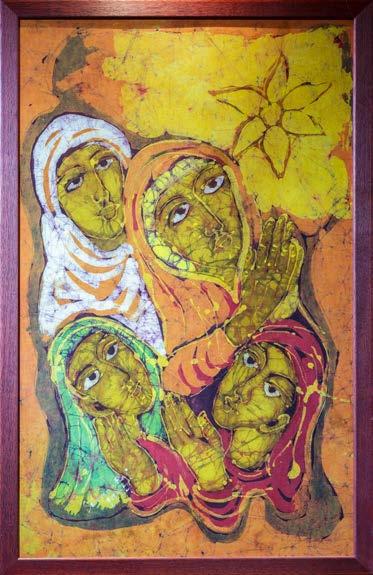
Solomon Raj (1921-2019)
Magnificat
Date unknown
Batik on cotton
108cm x 70cm
Loaned by Mrs Barbara Butler, Executive Secretary, Christians Aware
Photographer
Gareth Rainsforth
Date unknown
I have run conferences with Solomon, who was an Indian Lutheran minister who became well-known for his batiks. On one occasion we exhibited many batiks and I chose this one. It depicts longing, hope and faith.
(Barbara Butler, Christians Aware)
Solomon Raj Magnificat
the Sea
Recent humanitarian world events concerning the refugee crisis render this joyful watercolour by Heather Brown of especial relevance to the exhibition. The Kurdish people in the boat look forward with hope to a voyage which will culminate in a ‘promised land’ of safety and security. Some of them have prayerful gestures with clasped hands, whilst others play their instruments with exuberant abandon and anticipation.
We often place our faith in the kindness of strangers, as we arrive in a strange land.
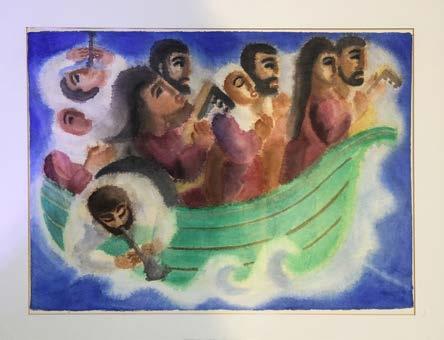
TAKE US TO THE SEA
(Maggie Jackson, Honorary Research Fellow, University of Chester)
Heather Brown
Take us to
Heather Brown (b. unknown) Take us to the Sea, 1993 Watercolour 57cm x 80cm Loaned by Revd James Buxton to Canon Jeremy at Chester Cathedral
Photographer Chris Bebbington
Jyoti Sahi
Biographical details
Born in Pune India in 1944, his father was a Hindu, his mother a Christian, and it was his father who decided he be brought up as a Christian. A close family friend was an artist and Jyoti comments ‘I can still remember the smell of paint which pervaded his studio. I was seven years old when I decided I would like to be an artist like him’.
Jyoti studied at Camberwell School of Art and Crafts in London from 1959 -63. After completing his Diploma, he was invited by Dom Bede Griffiths to join him in his newly founded Ashram in South India. After teaching art for some years in India, he joined Fr Bede and it was in this Ashram that he met his wife Jane, who is English, and from a Quaker background. They were married in 1970 and came to live in Bangalore where he was connected with the National Biblical, Catechetical and Liturgical Centre founded by the Catholic Bishops Conference of India, soon after the Second Vatican Council, to reflect on the relation of the Church in India to Indian Cultures and Spirituality. He is still linked to this centre, having founded an Ashram (The Indian School of Art for Peace) in a village outside Bangalore in 1984.
(Seeing the Spiritual: A Guide to the Methodist Modern Art Collection, 2018.)
Jyoti Sahi
Plucking the string that binds
Prior to 1996
“Plucking the String that Binds” takes as its inspiration a verse from George Herbert’s Poem ‘Easter.’
George Herbert (1593-1633) is the great Anglican priest-poet of the 17th century who forsook a life at court and in politics for the simplicity of local church ministry at Bemerton on the edge of the family estate of his relatives, the Earls of Pembroke. His poems were taken by his good friend Nicholas Ferrar who set up a community at nearby Little Gidding and published in The Temple (1633) which was published in eight editions before 1700. Several are still used as hymns by many Christian hymnals.
The poem Easter takes as its inspiration the psalm of praise (57) for the morning
service of Easter Day. Herbert likens the praise of those gathered for worship as musicians bringing their skills to bear on their instrument (here the lyre a symbol of poetry) with the emotions of the thankful heart seeking to make melody in the soul as well as on the “lute ad harp.”
Sahi takes the image of the player of the musical instrument and makes the latter central to his composition. The structure of the instrument resembles that of the swarmandal (Hindi:
surmandal or Indian harp which is a plucked box zither. The hands of the player are both plucking the strings and raised in adoration and praise as they make music which is the offering of the heart, expressed in the open lips, and hands. His use of materials including dry sand bring an earthiness to the divine creation of life out of death through God`s work on the Cross.
(Revd Dr Tim Macquiban, North Cheshire Methodist Circuit and Chester Cathedral)
PLUCKING THE STRING THAT BINDS
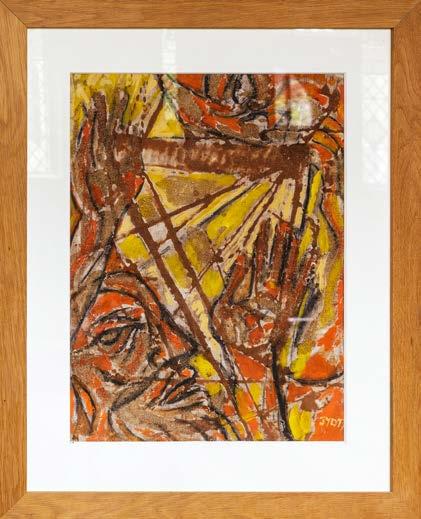
Jyoti Sahi (b.1944 - )
Plucking the string that binds, n.d. [prior to 1996] Pastel on sand 44cm x 41cm Loaned by Revd Dr Tim Macquiban, Chester.
Photographer Gareth Rainsforth
Rise heart; thy Lord is risen. Sing his praise
Without delayes,
Who takes thee by the hand, that thou likewise
With him mayst rise: That, as his death calcined thee to dust,
His life may make thee gold, and much more, just.
Awake, my lute, and struggle for thy part
With all thy art.
The crosse taught all wood to resound his name, Who bore the same.
His stretched sinews taught all strings, what key Is best to celebrate this most high day.
Consort both heart and lute, and twist a song
Pleasant and long: Or, since all musick is but three parts vied And multiplied,
O let thy blessed Spirit bear a part, And make up our defects with his sweet art.
(George Herbert 1593-1633)
1994
I have arranged several conferences and exhibitions for Jyoti Sahi and this painting was included in a Leicester exhibition in the 1990s. I liked it immediately. It is an Indian ‘Madonna and Child’ which is both hopeful and looking to the mountains and beyond and at the same time pointing to earthly dangers.
Butler, Christians Aware)
CHILD JESUS WITH BIRDS
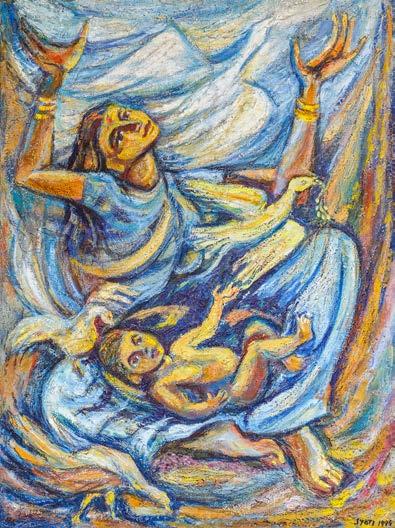
(Barbara
Jyoti Sahi
Child Jesus with Birds
Jyoti Sahi (b.1944 - )
Child Jesus with Birds, 1994 Oil on canvas 75cm x 100cm
Loaned by Mrs Barbara Butler – Executive Secretary, Christians Aware
Photographer Gareth Rainsforth
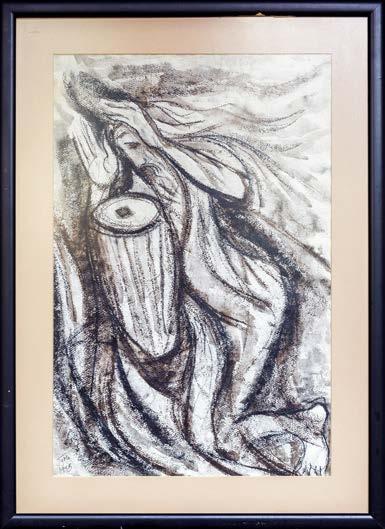
The drum is a regular focus for Jyoti who sees it as linking earth and heaven both through the shape of the drum and through the sounds. The drummer enables the link between the two.
DRUMMING CHRIST
(Barbara Butler, Christians Aware)
Jyoti Sahi
Drumming Christ 1995
Jyoti Sahi (b.1944 - )
Drumming Christ, 1995
Charcoal on paper
53cm x 35cm
Loaned by Mrs Barbara Butler, Executive Secretary, Christians Aware
Photographer Gareth Rainsforth
Jyoti Sahi
Journey to Emmaus Presence & Blessing
2002
These two symbolic paintings by Jyoti Sahi represent a crucial moment in time when at the journey’s end the very presence of Christ is made known to his disciples and fellow travellers. Luke’s gospel tell us that although Christ is walking with them, they do not recognise him, but nevertheless with care and hospitality ask him to stay. ’Abide with us; for it is toward evening and the day is far spent’.
The passage emphasises to us the importance of the moment of recognition when Christ breaks the bread. Henceforth everything is transformed by this one prescient act and can never be the same again.
In Caravaggio’s ‘Supper at Emmaus’ in the National Gallery, the moment of revelation is depicted like
a cinematic snapshot, full of gesture and incident. Relationships are altered forever.
By contrast, Sahi’s figures in ‘Presence’ are viewed from a distance, perhaps displaying wonder and astonishment? Barbara Butler tells us that the feet which are central to the painting, represent the Resurrection and this particular form of representation is also evident in the Dalit collection, which also formed part of the exhibition.
In ‘Blessing’ the figures are cupped in a mandorla, formed by forearms and hands which are arched upward, the left hand signalling the sign of the peace. Luke concludes in the gospel, ‘did not our hearts burn within us while he talked to us by the way and opened to us the scriptures?...the Lord is risen indeed.’ ( Luke 24,13-34)
(Maggie Jackson, Honorary Research Fellow, University of Chester)
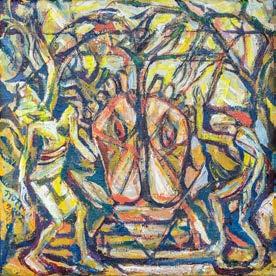
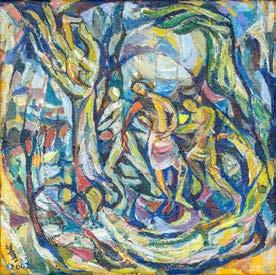
60cm
Loaned
Mrs Barbara Butler – Executive Secretary, Christians Aware
Photographer
Gareth Rainsforth
Jyoti Sahi (b.1944 - )
Journey to Emmaus – Blessing, 2002 Oil on canvas
60cm x 60cm
Loaned by Mrs Barbara Butler – Executive Secretary, Christians Aware
Photographer
Gareth Rainsforth
Jyoti Sahi (b.1944 - )
Journey to Emmaus – Presence, 2002 Oil on canvas
x 60cm
by
The Professor Robert Roaf Icon Collection Biographical details
The icons were donated to Liverpool University by Professor Robert Roaf who was Professor of Orthopaedic Surgery at the University from 1964 to July 1976. After graduating from Oxford in 1934, with a first class honours degree in physiology, he qualified in medicine in 1937. In 1939 he was admitted as a Fellow of the Royal College of Surgeons in Edinburgh, in 1942 of the Royal College of Surgeons in England, and in 1946 he achieved the Mastership in Orthopaedic Surgery. Professor Roaf showed academic interest in his subject very early, and this was recognised by his appointment in the University as part-time lecturer in 1947, and in 1955 as Director of Clinical Studies and Research at the Robert Jones and Agnes Hunt Orthopaedic Hospital in Oswestry. He held appointments as consultant orthopaedic surgeon not only to the Liverpool Teaching Hospital, but also to several hospitals in the Region. His research work on spinal deformities gained him international recognition, and he travelled widely, teaching and demonstrating over the Indian Sub-Continent and Africa as well as in Europe, America, Russia, South East Asia and China. He was consulted at a national level on orthopaedic problems, and was a member of the Central Accident Services Review Committee set up by the National Health Service. Professor Roaf was also a Member of the General Medical Council and from 1971-74 was Pro-Vice-Chancellor of the University.
(Taken from the Liverpool University biographical records)
Russian School
Entry into Jerusalem c.19th century
Christ’s entry into Jerusalem is celebrated on Palm Sunday. This version of the subject was current in both Byzantine and Western medieval art. It is both a description of an event and a symbol of Christ’s entry into the Kingdom of God. In both cases it is a triumph, and the icon is a joyful one. Christ rides on a white donkey, a group of Apostles behind him, a group of Jews bearing palms coming out of Jerusalem to greet him. Above and below are children throwing down palm leaves and garments for him to tread on. The children are symbolic of those who received Christ with innocence, unlike their elders, who expected Him to destroy their enemies in this World. The palms are the greeting for heroes in the Jewish world, and the garments indicate that He is an anointed king.
(Text from booklet: Icons presented by Professor Robert Roaf FRCS in the University of Liverpool Gallery, 1986)
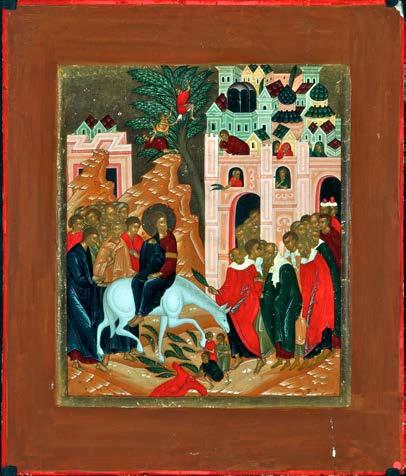
Russian School
Entry into Jerusalem, c.19th century Tempera and gilding on panel
31cm x 26cm
Loaned by the University of Liverpool Museum and Galleries
ENTRY INTO JERUSALEM
Photography courtesy of Liverpool University
Photographer
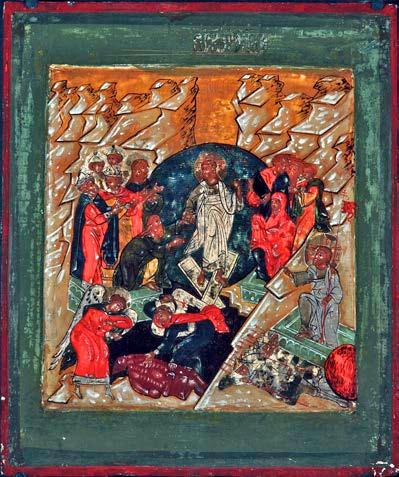
Russian School
The Anastasis is celebrated on Easter Saturday. This icon illustrates the dogma that when Christ dies on the Cross he descended into Hell, where he brought Redemption to the souls who had lived before him. In English it is called the Harrowing of Hell. The image is a traditional one…The figure of Christ tramples on the gates of hell over the abyss, with his right hand he pulls Adam towards him, Eve waits her turn with her hands veiled. Behind Adam and Eve are kings, prophets and priests of the old dispensation, none are identified but David, Solomon and John the Baptist are always among them. Below are two angels attacking the prone figure of the Devil. In the foreground, separated from the Harrowing of Hell by a mountain, is the Resurrection, showing Christ climbing out of a sarcophagus above the sleeping guards. This is a Western image…It was much used in the Italian Renaissance and came to Orthodox iconography from the West in the late seventeenth century.
HARROWING OF HELL AND THE RESURRECTION
(Text from booklet: Icons presented by Professor Robert Roaf FRCS in the University of Liverpool Gallery, 1986)
Harrowing of Hell and the Resurrection c.17th century
Russian School
Harrowing of Hell and the Resurrection c.17th century
Tempera, gilding and silvering
32cm x 27cm
Loaned by the University of Liverpool Museum and Galleries
Photographer Photography courtesy of Liverpool University
Cretan School
Holy Trinity with Dove c.17th century
Artists from Constantinople established themselves in Crete, as elsewhere after the fall of the Empire. Crete was part of the Venetian Empire, which was a melting-pot for East and West. This image of the Holy Trinity is in a Western iconography, the Father and Son identical and the Holy Ghost as a Dove. Father and Son are borne up by the Cherubim and their feet rest on clouds. Between them they hold the globe of dominion, the Father holds a sceptre and the Son makes a gesture of blessing. The figures are solidly three-dimensional, though the highlights on the robe of the Son are picked out in a network of fine gold lines, a characteristic and decorative feature of Byzantine art which resulted from the continual creation of new images on the basis of old and without reference to nature.
(Text from booklet: Icons presented by Professor Robert Roaf FRCS in the University of Liverpool Gallery, 1986)
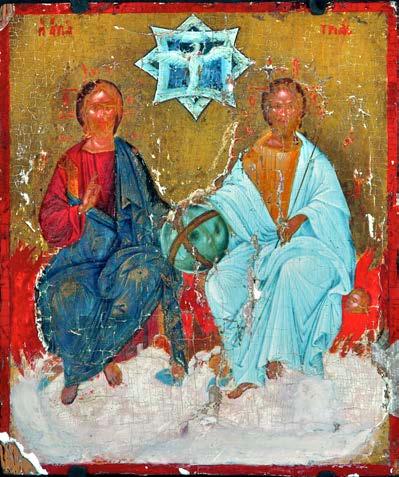
HOLY TRINITY WITH A DOVE
Cretan School
Holy Trinity with Dove, c.17th century Tempera and gilding on panel 22cm x 18cm
Loaned by the University of Liverpool Museum and Galleries
Photographer Photography courtesy of Liverpool University
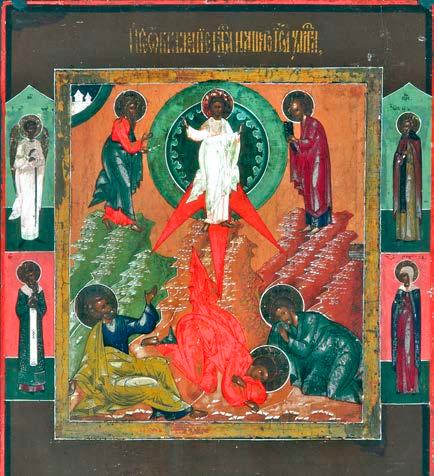
Russian School
Transfiguration
The feast of the Transfiguration is celebrated on 6th August in the Orthodox Church. Images occur from very early times, the earliest of them (e.g. St Apollinaire in Classe, Ravenna) are symbolical, but these were soon supplanted by illustrations of the biblical text. Our icon is in the classical form, Christ central between Moses and Elias on the mountain top with the agitated figures of the Apostles below. The event is seen as having various theological meanings: it demonstrates the dual nature of Christ as God made Man and prefigures the Resurrection. The colouring of this icon is particularly brilliant, the white robes of Christ reflect the text, but for the rest the artist has taken pleasure in a rich display, the scarlet and gold of St. John being particularly luxurious. The evocation of highlights by flat white areas is notable. The Kingdom of Heaven appears in a quadrant at the top left.
TRANSFIGURATION OF OUR LORD JESUS CHRIST
(Text from booklet: Icons presented by Professor Robert Roaf FRCS in the University of Liverpool Gallery, 1986)
of Our Lord Jesus Christ, c.19th century
Russian School
Transfiguration of Our Lord Jesus Christ, c.19th century
Tempera and gilding on panel
31cm x 27cm
Loaned by the University of Liverpool Museum and Galleries
Photographer Photography courtesy of Liverpool University
A Madonna for our Times
Our Lady of Perpetual Succour, Stella Maris, the’ Madonna of the Snows’; these are all poetic titles which have been ascribed to the Virgin Mary. Her cult reached its height in the thirteenth and fourteenth centuries, when pilgrimage sites such as Walsingham and Chester abounded and when she was viewed as the chief intercessor between God and Mankind in prayers. She is depicted in the early Renaissance as ‘The Queen of Heaven”, having ascended to the right hand of Christ her son, or as ‘Sedes Sapientiae’’ the Throne of Wisdom’.
In European image making she becomes more realistic in depiction with the passage of time and the Christ child more human and believable. She is traditionally dressed in celestial blue, the colour of Heaven and often displays a kind of gentle meekness; the ideal of womanhood in the Middle Ages to which women should aspire. In Dante’s ‘Divine Comedy’, Paradiso canto xxxiii, Dante and Beatrice encounter her at last, placed in a floating mandorla and surrounded by saints. ‘So these white radiant beings reached above themselves with all their fire, and it was plain to me how each one felt the deepest love for Mary as they sang the sweet refrain ‘Regina Coeli’, Queen of Heaven. So sweet was their song that it is with me still as always.’ (James 2013, p.142)
In this exhibition we were fortunate enough to possess several contemporary Madonna and Child images which ranged over cultures,
nations and artistic styles, from the Byzantine Russian Madonna donated by our partner church, much kissed and venerated, to the Ballinger Madonna print which mirrors its predecessors in colour, style and composition, but represents contemporary black motherhood in a touching and tender way to which all can relate.
Yvonne Bell’s ‘Mother of God of Clemency’ has a strong narrative message in both the making and the meaning, as does Brenda Joysmith’s image of a black mother and child clothed in winter white, against a white background; maternal love personified. In Barbara Butler’s collection of wooden African carvings, one of the women carries her child in a papoose on her back, whilst working and travelling. Another clasps the child close to her breast. These Madonnas speak of a significant re-alignment and re-interpretation. A new inclusive vision. A Madonna for our Times.
‘Hear o Heaven, hear my words
Full of longing and pervaded by joy.
Tell me, I pray, who is she
That shines like the dawn in her rising That I might bless her?
Tell me, for she, beauteous as the moon, Radiant as the sun, fills with joy
The earth, heaven and seas.’
(Monteverdi’s Vespers, 1610, trans. John Kilpatrick)
(Maggie Jackson, Honorary Research Fellow, University of Chester)
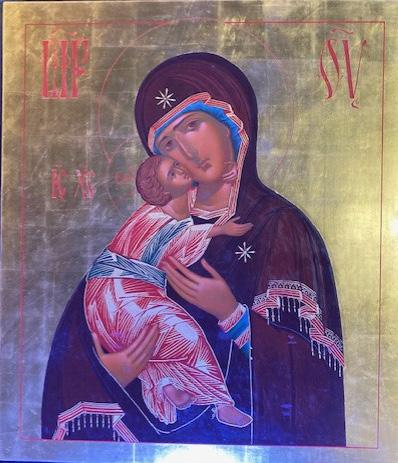
Julia Bolsakov and team (date unknown)
Russian Madonna Icon, 2009
Egg Tempera and 23 carat gold leaf on hardwood 81cm x 70cm
Chester Cathedral Collection
Photographer Chris Bebbington
Julia Bolsakov and team
Russian Madonna Icon 2009
The Russian Madonna Icon was written by Mother Julia Bolsakov and her team in the Kondopoga workshop in Russia. This, together with two other icons in the collection were commissioned by Chester Cathedral to commemorate the formation of the link between the two churches in 2009.
(Chester Cathedral)
RUSSIAN MADONNA
Unknown Artist
The Ebony Madonna and Child
Date Unknown
Little is known about this beautiful, highly polished ebony sculpture of Madonna and Christ child, which stands a metre or so high. It is finely crafted with delicate detail on the drapery of the gown and the folds of the headdress which partially covers the carefully sculpted curls. The dress and demeanour are suggestive of traditional representations of the Virgin, adding to the difficulty in dating the piece.
The Christ child is lively and boisterous, eagerly suckling the breast, but the young Madonna has a pensive air, perhaps suggestive of the sorrows to come. This is a pose which is often adopted in early interpretations of her role.
Ebony is a hard and expensive wood to sculpt and the provenance of this piece is unknown, but its tranquil tenderness mark it out for contemplation upon this most universal yet special of relationships.
(Maggie Jackson, Honorary Research Fellow, University of Chester)
THE EBONY MADONNA AND CHILD
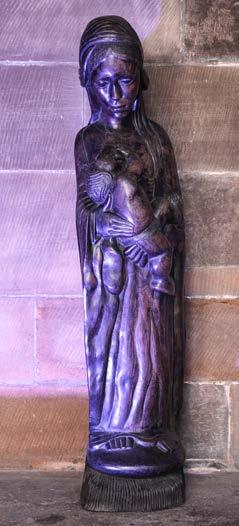
Unknown Artist
The Ebony Madonna and Child
Carved Ebony h. 100cms Loaned by Lambeth Palace
Photographer
Chris Bebbington
Memphis native Brenda Joysmith is recognised nationally and internationally for her skill as a pastellist and is best known for her positive depiction of the Black community. Inspired by her surrounding family, neighbours and community, she sensitively portrays the familiar, individuals, family and public scenes. Joysmith deftly used pastel to convey the subtleties of personality, nuances of gesture, and the style and natural rhythms of a nurturing Black experience.
Brenda returned to her native Memphis after living for 25 years in California. She says “The last 25 years in California have expanded my view of the diversity of Black people. Our experience varies by region, generation, religion or socio-economic status. However, most of our cultural roots take us back to the South. I want to remind us of the strengths and positive substance of that experience, connecting with the universal and the timeless.”
(UAPB News, March 1st 2020 and Brenda Joysmith Bio)
Brenda Joysmith
The psychiatrist Dr Jean Shinoda Bolen writes “When you recover or discover something that nourishes your soul and brings joy, care enough about yourself to make room for it in your life.”
My early years’ Illustrated Children’s Bible did not ever suggest to me that the Mary as God Bearer could connect to me in such a personal way, as racially she looked more like my friends; and we now know how vital it is to offer an alternative narrative in words and pictures on the story of God other than the white western perspective.
In this picture, the contrast of the white shroud juxtaposed against the skin colour of Mary and Jesus forces the observer to recognise and accept and see their blackness. This piece of art connects me to an experience of black visibility held in the visibility of God.
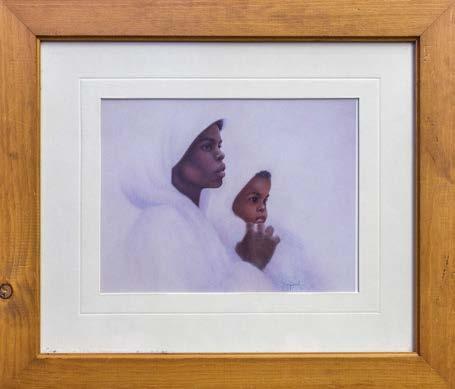
MADONNA
Brenda Joysmith (b. 1952 - ) Madonna, 1984 Print, open edition 18cm x 23cm
Loaned by Venerable Karen Lund, Archdeacon of Manchester
Photographer Gareth Rainsforth
(The Venerable Karen Lund, Archdeacon of Manchester)

As far as Bishop Guli is aware, the picture was made by a Persian artist for a CMS missionary in Iran called Robin Waterfield, who retired back to England. In the early 2000s, and approximately 2 years prior to his death, Robin gifted the picture to Bishop Guli. The Persian style mother and child is seen from the head-dress down to the shoes. The picture is drawn in white ink and dates from the 1970’s.
(Jane Carter -Secretary to the Bishop of Chelmsford)
Persian Artist – name unknown Mother and Child, circa 1970s
Ink on paper
71.5cm x 41.5cm
Loaned by The Rt Revd Guli Francis-Dehqani, Bishop of Chelmsford
Photographer Gareth Rainsforth
MOTHER AND CHILD
Unknown Artist Mother and Child
Ballenger Print
The Black Madonna
Date unknown
This Black Madonna and Child art print is by Ballenger. A friend in New York sent it to me in the 90’s. I remember being blown away by the image and spent a long time simply being immersed in it. I spent a long time trying to work out why I was so drawn to the image. It then dawned on me – this was the first time that I was seeing myself reflected in the life of the ‘holy family.’ They looked like me! It was as though a mirror had been held up and I was seeing a reflection of myself at the heart of the story of God incarnate – God becoming HUMAN!
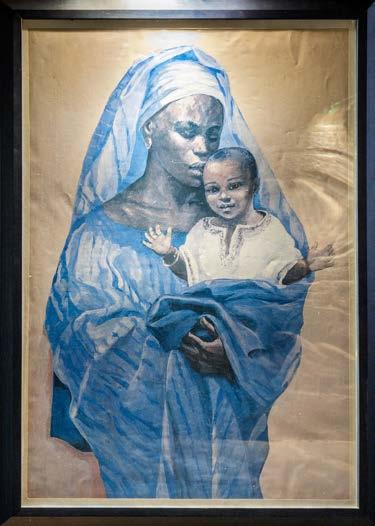
THE BLACK MADONNA
(The Rt Revd Rose Hudson-Wilkin, Bishop of Dover)
The Black Madonna (date unknown) Fine Art Print on paper 100cm x 70cm On loan from Bishop Rose Hudson-Wilkin
Photographer Chris Bebbington
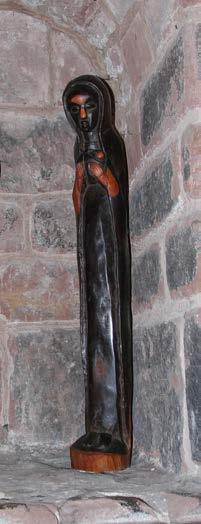
Progress Mukela (Date unknown)
Madonna and Child
Carved wood
Height 95cm
Loaned by Mrs Barbara Butler, Executive Secretary, Christians Aware
Photographer Chris Bebbington
Progress Mukela
Madonna and Child
Date unknown
This is a much smaller version of the Madonna and Child in Lusaka Cathedral. Both were created by Progress Mukela. I liked his carving in the cathedral and asked if he would create the smaller version for us. We lived in Lusaka for five years.
(Barbara Butler, Christians Aware)
MADONNA AND CHILD
Unknown Artist - Malawi Mother and Child
This piece is from Malawi and I do not know who carved it. I chose it because it expressed something of the life of a rural African woman.
(Barbara Butler, Christians Aware)
MOTHER AND CHILD
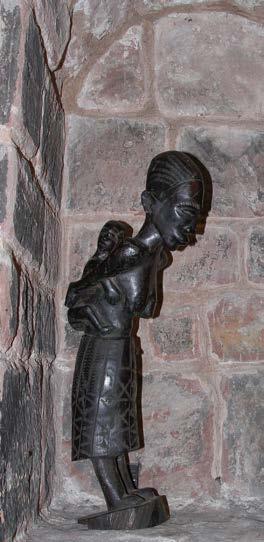
Unknown Artist – Malawi Mother and Child
Carved Wood Height 75cm
Loaned by Mrs Barbara Butler, Executive Secretary, Christians Aware
Photographer Chris Bebbington
Meg Wroe graduated from Central St Martin’s University of the Arts London, in 2006, and did post-graduate studies at the Art Academy, London Bridge in 2016/17. She has exhibited in solo and group shows and delivered art workshops in Bethlehem, South Africa and Brazil, making her own work around these experiences. Meg also visits the Scottish Isle of Iona each year, “where the sea and sky meet blue on blue”.
She first painted a ‘Trinity - After Rublev’ after being moved by a talk on diversity in the church, and the lack of diverse images in all churches.
Her first painting was for her own home church in Holloway, but has also been shown in St Paul’s Cathedral and Southwark Cathedral. After the display in Southwark Cathedral, Meg was commissioned in 2018 to paint a ‘Trinity - After Windrush’ for the Southwark diocese.
The painting is on wood, carved to create texture, then painted in acrylic paint, mixed media and gold leaf.
(Taken from megwroe.com and The Venerable Dr Rosemarie Mallett, Archdeacon of Croydon)
Meg Wroe
Biographical details
Meg Wroe
Trinity after Rublev, Southwark - Windrush Icon
2018
The Bishop of Southwark, the Rt Revd. Christopher Chessun, together with the Diocesan Department of Justice, Peace and the Integrity of Creation (JPIC) commissioned an icon reflecting the ethnic diversity of the Diocese. The icon was to be similar in style to the ‘Trinity – After Rublev’ Icon painted for St. Luke’s, Holloway, by the artist Meg Wroe.
The idea for a Diocesan Icon reflecting ethnic diversity came about after the Diocese held a Black History Month thanksgiving event in 2017, which focused on ‘Art, Culture & Representation’ in liturgy and church life, and the scarcity of artwork representing Black, Asian and Ethnic
Minority (BAME) people in liturgy, religious iconography and worship materials. Meg Wroe’s St Luke’s icon was displayed at the event and appreciated by all who viewed it.
The Southwark Icon depicts three people to signify the history, story and legacy of BAME involvement and engagement in the life and ministry of the Diocese, and also mark the celebration of the 70th anniversary of the arrival of MV Windrush and the inception of the NHS in 1948. BAME contributions to the country at large due to presence and their involvement in the NHS are a significant part of our national story in recent decades.
The History of the Windrush is represented by Mr Bertram Dixon who came to the UK as part of the Windrush generation. The story of BAME people in the UK is represented by Shirley Coker who
worked as an NHS nurse for many years. The Legacy of BAME people in the UK is represented by Oluyinka Ladipo a young adult living in the Diocese of Southwark. There is in the icon an image of a church and a boat to symbolise the journeys and travels of all Christians, right from the initial call to the disciples.
The Icon was unveiled and blessed at the Diocese of Southwark’s 2018 Black History Month Thanksgiving service on the 6th October 2018 at Southwark Cathedral, by Bishop Karowei Dorgu, Bishop of Woolwich. The Cathedral then displayed the icon for the duration of Black History Month and it is now available to be used in parishes throughout the Diocese, the purpose for which it was commissioned.
(The Venerable Dr Rosemarie Mallett, Archdeacon of Croydon)
TRINITY AFTER RUBLEV, SOUTHWARK
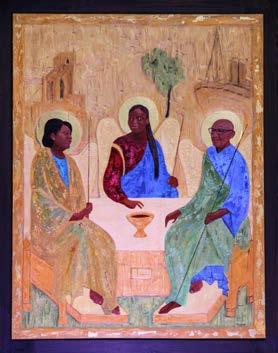
Acrylic, mixed media and gold leaf on carved wood
80cm x 60cm
Rt
Meg Wroe (b. unknown)
Trinity after Rublev, Southwark, 2018
-The Windrush Icon
Loaned by The
Revd Christopher Chessun, Bishop of Southwark
Photographer
Chris Bebbington
Terry Duffy
Biographical details
Terry Duffy is an international artist with a reputation for unique, challenging work. He has exhibited in London, Paris, Berlin, Cape Town, Dresden, New York and more. Duffy was born in Liverpool and at the age of 13 won a scholarship to art school. Following this he trained as a lithographer and photographer, and for several years worked in print and design studios in London. He founded Arena Studios, Liverpool in 1985 and the British Art and Design Association in 1986. From 1986-92 he was Head of the Faculty of Art and Design at City College, British Council Professor of Fine Art in Budapest in 1992, and Chair of the Liverpool Independents Biennal in 2008. He has received several major awards and international media recognition.
(The Vessel, Terry Duffy, 2021)
2018
This specially commissioned ceremonial robe tells the story of life in Britain for the Windrush generation and their descendants.
The cope, created by internationally renowned artist Terry Duffy, features a photo montage illustrating black history in Britain since the arrival of the MV Empire Windrush on June 22nd, 1948, including the original 1948 ‘British citizen’ passport issued to Alford Gardner, a passenger on the ship, and an image of Sam King, another of the ship’s passengers, who later became the first black Mayor of Southwark. The image of the Jamaican-born Rev Rose Hudson-Wilkin, once Chaplain to the Speaker of the House of Commons, and now Bishop of Dover, is also included.
The cope also makes reference to the murder of Stephen Lawrence and alludes to racial discrimination faced by Caribbean migrants in post-war Britain including the sign ‘No Irish, No blacks, No dogs’ a familiar notice displayed in the windows of some boarding houses with rooms for rent.
The Windrush cope has been kindly loaned to the Diocese of Chester by the Church of England’s National Committee for Minority Ethnic Anglican Concerns specifically for the Global Images of Christ Exhibition.
(Revd Vanessa Layfield, Engagement and Inclusion Officer, Diocese of Chester)
THE WINDRUSH COPE
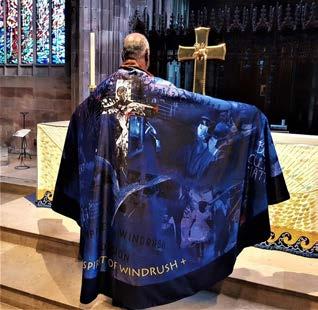
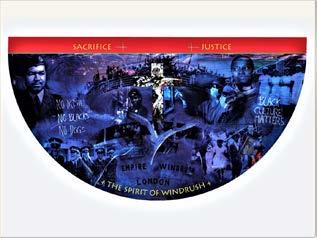
The Windrush Cope
Terry Duffy
Terry Duffy (b. unknown)
The Windrush Cope 2018 Digital Print on Fabric Loaned by The National Committee for Minority Ethnic Anglican Concerns
Photographer Courtesy of Terry Duffy
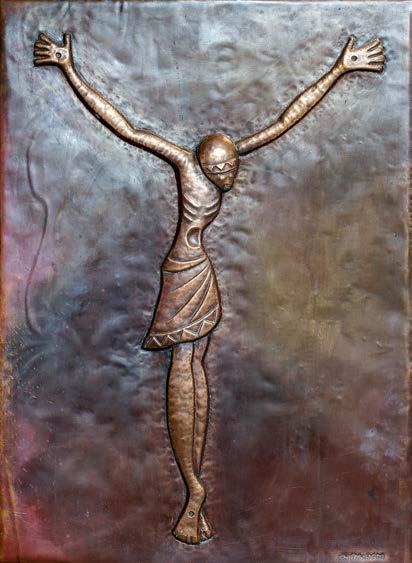
Chem Chem, the Congo
Crucified Christ, c.1990
Copper Relief
57cm x 41 cm unframed
Chem
These panels were bought, so far as we remember, at the Benedictine Monastère NotreDame-des-Sources, Kiswishi, near Lubumbashi, Zaire (now DR Congo) about 1991. We know nothing about ‘Chemchem’, if that is the name of the artist as one assumes. Lubumbashi, the second city of the country, is the heart of the Congolese side of the Copperbelt, near the Zambian border, and so the copper sheeting from which these are crafted is easily available. We bought these reliefs as a memento of our years living and working there, keeping the Crucified Christ and giving the other to our friends. The phrase ‘hollowed out’ is one which comes to mind as one contemplates this representation of Jesus. It conveys something of the dignified and often joyful resilience of the people of the Congo, in the face of decades of suffering.
CRUCIFIED CHRIST
(The Revd Canon Dr Tim Naish, Canterbury Cathedral)
Chem, the Congo Crucified Christ c.1990
Loaned by The Revd Canon Dr Tim Naish and Mrs Hilary Naish
Photographer Gareth Rainsforth
Chem Chem, the Congo
Simon of Cyrene and Jesus c.1990
SIMON OF CYRENE AND JESUS
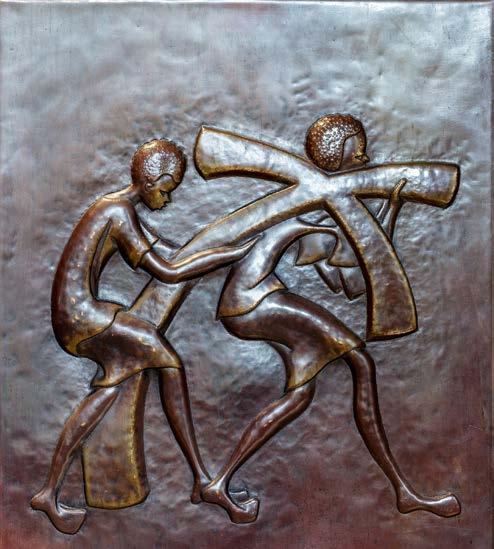
Chem Chem, the Congo Simon of Cyrene and Jesus, c.1990 Copper Relief
54cm x 43cm unframed
Loaned by The Rt Revd Dr Graham Kings and Mrs Alison Kings
Photographer
Gareth Rainsforth
Biographical details
Yvonne Bell is a Christian artist who was trained in iconography by Dom. Anselm at the Abbey of Our Lady and St John at Alton in Hampshire. Yvonne works from her Northamptonshire studio. In addition to being an iconographer she also designs church vestments with painted silk panels as well as banners, chasubles, stoles, copes, mitres, lectern and pulpit falls and altar cloths.
(Yvonne Bell)
Yvonne Bell
Painted in April 2020 in response to politics around the world. I googled a selection of African male faces and lived with them for a while until parts of each face became noticeable. So, the face I drew was not one that already exists but a new face.
I painted his eyes first so that I could see him and he could see me while I painted him. The idea when painting an icon is to pray with the person you are painting – and let them sit with you.
His cloak is taken from a Kenyan printed fabric.
(Yvonne Bell – Christian Art and Church Vestments/christian-art.vpweb.co.uk)
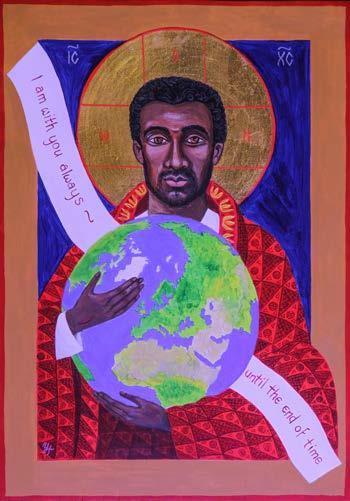
ICON OF CHRIST - YESHUA’S PROMISE
Yvonne Bell
Icon of Christ –
Yvonne Bell (b.1951 - )
Icon of Christ – Yeshua’s Promise, 2020
Acrylic and 23 carat gold leaf on 22mm plywood
42cm x 30cm Loaned by the artist
Photographer Chris Bebbington
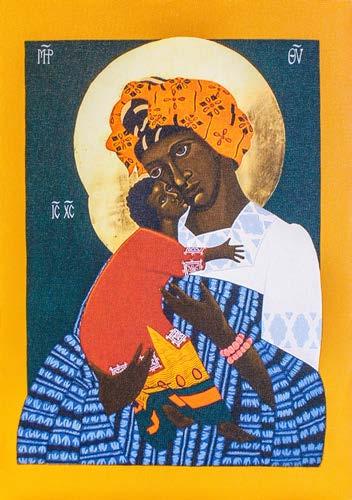
I was commissioned to write this icon by a church in London who wanted a painting in memory of one of their teenagers who had died in a road accident outside the church.
I arranged to paint the icon at Alton Abbey during an icon painting week arranged by Dom Anselm the iconographer. I arrived with a drawing taken from The Mother of God of Vladimir wearing a genuine African fabric print that I had researched.
When painting an icon, you paint the face first because you are then looking into the eyes of the person you are creating in paint. She looks back at you.
When attempting to paint Christ’s top white, a voice in my mind shouted “It’s got to be red” I said no and she repeated the command. Her voice. She shouted at me until I mixed up red paint and used it.
Yvonne Bell (b.1951 - )
Mother of God of Clemency, 2010
Canvas print of original painted with egg tempera and 23 carat gold leaf on Iroko African Hardwood 42cm x 30cm (Print size)
Loaned by the artist
Photographer Gareth Rainsforth
Yvonne Bell
Mother of God of Clemency 2010
Hymn to Mary, and the words “O Clement, O Merciful” made me feel that she was telling me something. I could feel a giggling sensation every time I sang the word Clement. So I called the icon The Mother of God of Clemency.
When I phoned the vicar to say that the icon was finished and told her the title – she said “yes - that would be right. When the teenager died, he had just stolen something and was in need of clemency”.
(Yvonne Bell – Christian Art and Church Vestments/christian-art.vpweb.co.uk)
In the evenings, we would all go to the chapel to sing Compline. The last piece was
MOTHER
Yvonne Bell
African Saint – St Bernard
Mizeki Icon
2008
Bernard Mizeki was born, probably in 1861, on the shores of the Bay of Inhambane, in Mozambique south of Beira. Aged 14, he travelled to Cape Town with other young men to look for work. He found work in a butchery and during his time there he came into contact with the Anglican Church. He was baptized and confirmed. Although he did not begin his education until late he had particular gifts for music and languages. He was also a man who prayed much, and his gentleness and graciousness impressed all who met him. In time he came to believe that God was calling him to be a missionary. His chance came in 1891, when Bishop Knight-Bruce recruited him to join a party to make the difficult journey via Beira into Eastern Zimbabwe to found the new diocese. Mizeki was given the task of living among Chief Mangwende’s people near Marondera, and to build up the mission there. For the next five years, Mizeki worked hard and after a time, he became a key member of the small group which was given the task of producing part of the Prayer Book and the Scriptures in
the vernacular. He soon realised that the belief of the local people was something to be respected, and upon which he could build. His humility was such that he destroyed furniture he had built for himself because he wanted to live the same life as those around him His identification with Mangwende’s people became even more complete when he married a young woman called Mutwa, who was related to the Chief. Converts began to gather round Mizeki but some of his teachings aroused jealousy. So, when the behaviour of many white settlers provoked the first great rebellion anyone associated with them was under threat. Mizeki was advised to leave his post and seek safety until peace was restored. He refused to leave his converts, and on 18 June 1896, he was speared to death by two of Mangwende’s sons. Mutwa escaped, and in November gave birth to a daughter, Bernardina. Mizeki’s life and death have deeply influenced the Anglican Church in Zimbabwe. His memory is preserved by books that have been written about him, and schools named after him. The shrine which Bishop Paget caused to be erected at the site of his martyrdom is the scene of a huge open-air service held each year at the weekend nearest to 18 June.
(The Diocese of Southwark Website. The Bridge. Vol.7. no1. February 2002)
AFRICAN SAINT ST BERNARD MIZEKI ICON
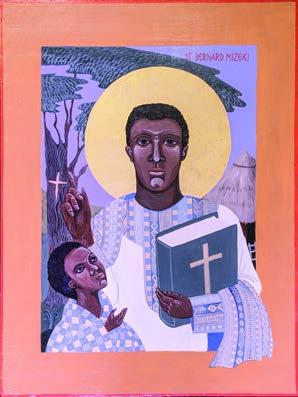
Loaned by The Very Revd Andrew Nunn, Dean of Southwark Cathedral
Yvonne Bell (1951 - )
African Saint – St Bernard Mizeki Icon
Photographer Chris Bebbington
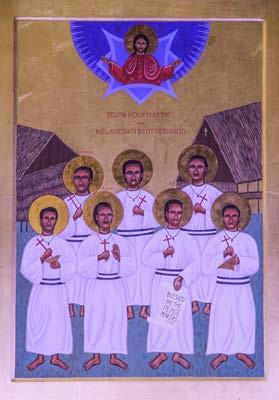
Revd Christopher Perrins (date unknown)
Seven Martyrs of Melanesia Icon (circa early 21st century)
Egg Tempera and 23 carat gold leaf
91.5cm x 68cm
Chester Cathedral Collection
Photographer
Chris Bebbington
A beautiful icon of the Seven Martyrs in the Solomon Islands was presented by the Companions of the Melanesian Brothers for the Martyrs Chapel in the South Transept.
Bishop Mark, Bishop Keith, Bishop Willy and his daughter Kate, Archdeacons Mike and Ian were amongst the small group who welcomed the icon in a short service. The icon was created by Revd Christopher Perrins who recalls the time of civil unrest in the Solomon Islands in early 2003.
Melanesian brothers are peacemakers belonging to the Anglican Religious Community of the Melanesian Brotherhood. Brother Nathaniel went to visit the leader Harold Keke on the Weather Coast of Guadacanal considering him to be a friend. He was tortured and murdered. Six brothers went to find him and request the body: three were killed immediately and the other three were killed the following day. The graves of the brothers are in Tabalia.
Chester Cathedral is honoured to recall the martyrs through the stunning icon. The icon is yet unfinished: after a year it will be varnished.
Jesus walked the way of the cross for love of your people; When our courage fails, may we call to mind the seven Melanesian Brothers and be strengthened to serve you.
Amen
(Chester Cathedral)
SEVEN MARTYRS OF MELANESIA
ICON
Revd Christopher Perrins
Seven Martyrs of Melanesia Icon (circa early 21st century)
Unknown ArtistChinese origin
Return of the Prodigal Son
The father, who is richly dressed in red, steps out of his house to clasp the outstretched hands of his son. The son, who is poorly dressed, kneels in supplication before his father, asking for forgiveness. A nearby basket and stick bear witness to his travels. Mountains appear in the distant landscape. This is a scene of reconciliation.
Jackson, Honorary Research Fellow, University of Chester)
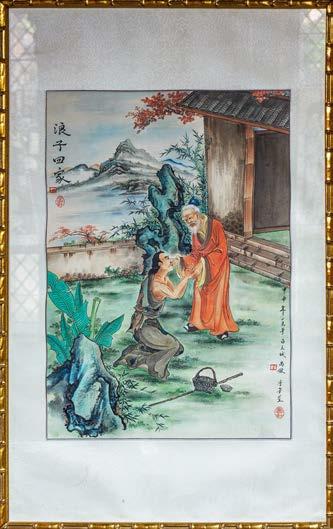
Artist – Chinese origin
RETURN OF THE PRODIGAL SON
(Maggie
Unknown
Return of the Prodigal Son Watercolour 54cm x 40cm
Loaned by Revd Canon Matthew Vernon Canon Pastor & Sub Dean, St Edmundsbury Cathedral Photographer Gareth Rainsforth
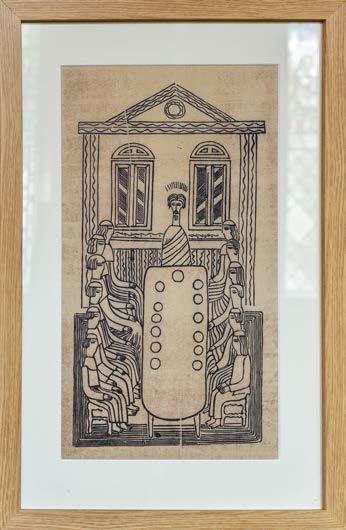
This woodcut has a beguiling simplicity and much of cultural interest in its crafting. The disciples are seated across a table in two rows and are tonsured. It is difficult to discern any individual characters, even Judas is not evident, and Christ is a single imposing figure at the head of the table, wearing a halo. The building itself is interesting, owing more to European than oriental architecture. Perhaps based on a Mission?
THE LAST SUPPER
(Maggie Jackson, Honorary Research Fellow, University of Chester)
Unknown ArtistChinese origin
The Last Supper
Unknown Artist –Chinese origin
The Last Supper
Woodcut
36cm x 20cm
Loaned by Revd Canon Matthew Vernon
Canon Pastor & Sub Dean, St Edmundsbury Cathedral
Photographer
Gareth Rainsforth
Unknown ArtistChinese origin
Hand held Prayer Crucifix
This small resin crucifix is vibrantly coloured in red and gold and could easily fit into the palm of one’s hand. At his feet his mother and a disciple bear witness to his death and an angel is depicted floating on the crossbar above his head. He wears the crown of thorns and is resigned to his fate with closed, downcast eyes.
Perhaps this piece, which is small enough to fit into a satchel, could be carried by an itinerant priest as a votive object, in the same way that portable altars have been.
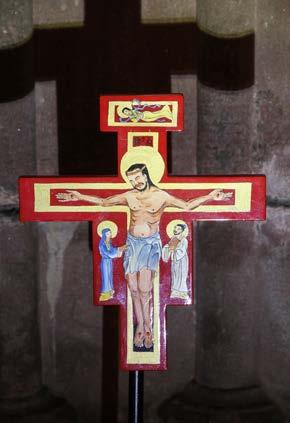
PRAYER CRUCIFIX
(Maggie Jackson, Honorary Research Fellow, University of Chester)
Unknown Artist – Chinese origin
Hand held Prayer Crucifix Resin h18cm x w16cm
Loaned by Revd Canon Matthew Vernon Canon Pastor & Sub Dean, St Edmundsbury Cathedral
Photographer Chris Bebbington
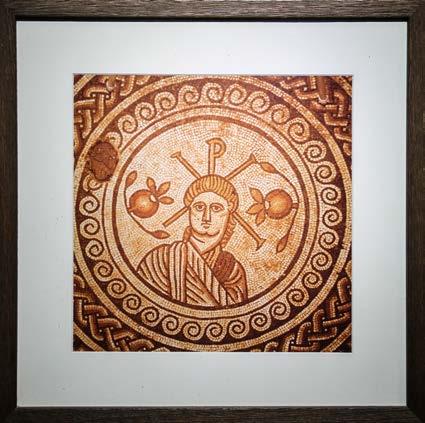
Unknown Artisans
Hinton St Mary Mosaic, AD 350
Photograph
37cm x 37cm
Loaned by The Rt Revd Dr Graham Kings and Mrs Alison Kings
The mosaic is at the British Museum
Photographer Chris Bebbington
Unknown Artisans Hinton St Mary Mosaic AD 350
The famous Roman mosaic of the face of Christ from about AD 350 at Hinton St Mary is one of the earliest known images of the face of Christ. It was discovered by accident in 1963 by a Baptist blacksmith, Walter White, and is now a centrepiece in the British Museum.
[adapted from https://www.fulcrum-anglican.org.uk/articles/doing-theology-as-a-bishop/]
‘Neil MacGregor, when he was Director of the British Museum, used it in his A History of the World in 100 Objects. Walter’s son, Paul White, is the pastor of an independent charismatic church in Weymouth and was a key figure in planning the ecumenical welcome for the sailing Olympics in 2012, when I was Bishop of Sherborne. When he came to a dinner at our house, he mentioned that he had grown up in Hinton St Mary. In response to my question about the mosaic, he said that it was his father who had discovered it, by putting a washing line pole in the ground. He framed a photo of it, as a gift, from his father’s negative.’
(The Rt Revd Dr Graham Kings, Hon Assistant Bishop, Diocese of Ely)
HINTON ST MARY MOSAIC
The Dalit Collection
Various images, c. 21st century
The Dalit Collection
A collection of prints provided by two Dalits who have been able to share work through this exhibition.
Rev. Jebasingh Samuel - was born and brought up in a small village near Madurai, Tamilnadu, South India. He is a Dalit (the so called untouchables), had experienced the common plight of oppression, untouchability and marginalisation. He studied his theology (Bachelor of Divinity) at Tamilnadu Theological Seminary, Arasarai, Madurai, South India. Rev. Samuel is an Ordained Vicar, serving as a priest at the Jaffna Diocese, Church of South India, in Colombo, Sri Lanka. He advocates tirelessly against caste violence and oppression. He also serves among the tea estates workers for their rights and justice.
Immanuel Paul Vivekanandh Karunakaran
Rev. Immanuel Karunakaran is an ordained minister in the Tamil Evangelical Lutheran Church (TELC) Tamilnadu, South India and has served as the Communications Secretary and Coordinator of the Dalit and Advasi (Tribal) Desk of the United Evangelical Lutheran Churches in India. With degrees in Theology from Gurukul Lutheran Theological College and Research Institute, Chennai, South India and McComic Theological Seminary, Chicago, IL. Immanuel is currently a Ph.D research student at Chicago in the field of Ethics, Church and Society. An activist, scholar and pastor serving the local Church in Chicago. Married to Cynthia Esther Varghese. They are blessed with two daughters - Sheryl & Maryl.
(Revd Dr Jacob and Revd Dr Jasmine Devadason, St Catherine’s Church, Heald Green)
THE DALIT COLLECTION
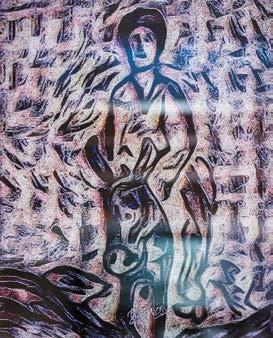
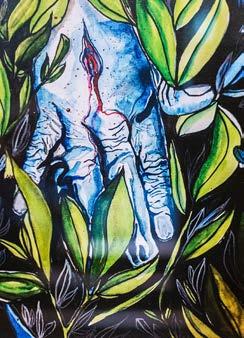
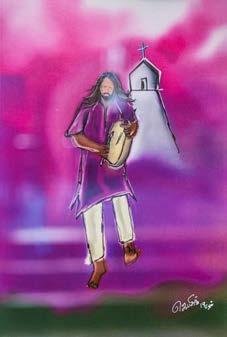
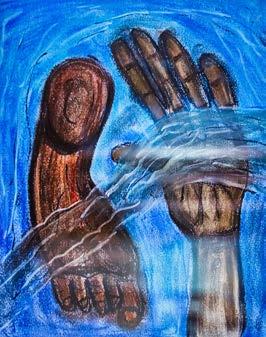
Various images, c. 21st century Prints from original paintings
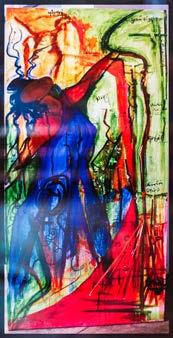
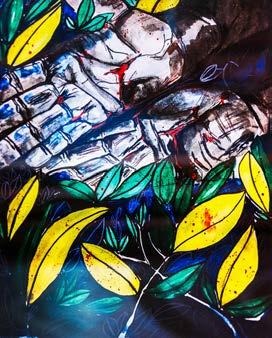
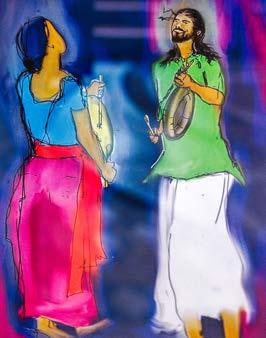
The Dalit Collection
Compiled by Jasmine and Jacob Devadason, Chester Diocese
Photography Courtesy of the artists.
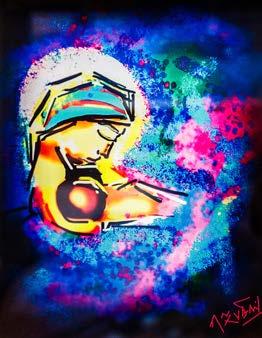
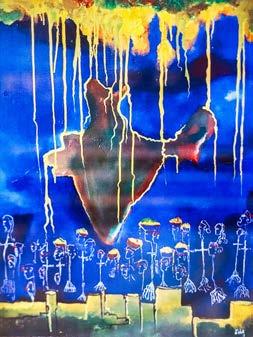
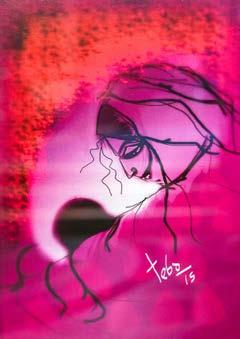
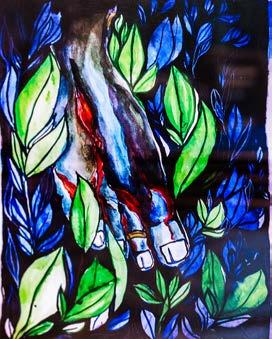
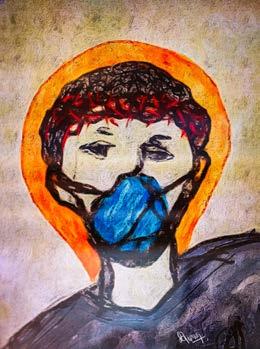
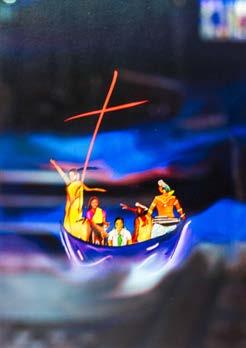
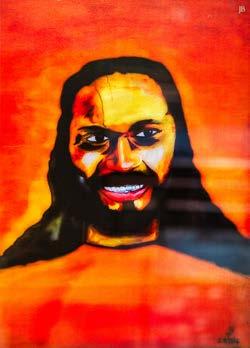
Various images, c. 21st century Prints from original paintings
The Dalit Collection
Compiled by Jasmine and Jacob Devadason, Chester Diocese
Photography Courtesy of the artists.
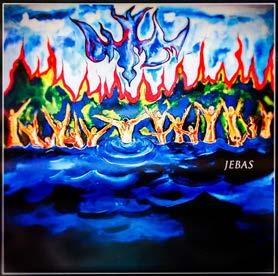
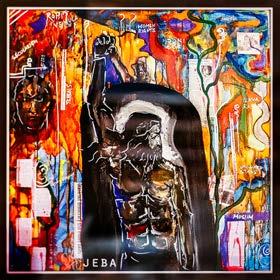
Various images, c. 21st century
Prints from original paintings

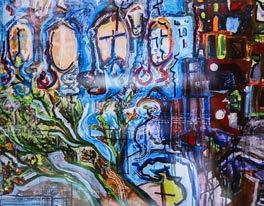
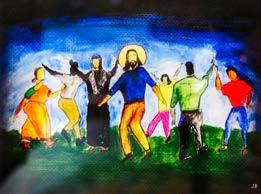
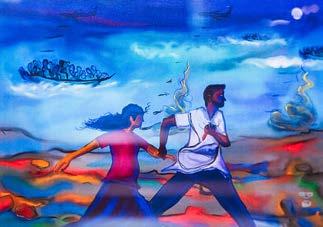
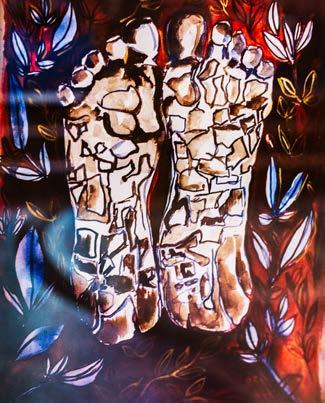
THE DALIT COLLECTION
The Dalit Collection
Compiled by Jasmine and Jacob Devadason, Chester Diocese
Photography
Courtesy of the artists.
Art Academics join Chester Cathedral on the ‘Global Images of Christ: Challenging Perceptions ‘Exhibition
University of Chester ‘Forum’ Magazine , October 2021.
Maggie Jackson, Honorary Research Fellow and Visiting Professor Maureen Wayman, OBE, who both support the work of the Department of Art & Design at the University, have worked closely with Canon Jeremy Dussek on gathering the pieces and curating the exhibition; exhibits have come from across the globe including from Africa and Asia.
Jeremy said:
“The idea for the exhibition was developed in response to the Black Lives Matter discussion last year and how working together in the Cathedral , University and city we could respond in a positive and cultural way.
We gathered the art pieces to challenge how humans tend to see Christ through their own cultural lenses.The exhibition challenges how individuals see Christ and how he is viewed in other countries. We want to demonstrate that Christianity is for everyone.”
Maggie said:
“It has been a privilege working with Maureen and Jeremy to bring together colleagues from the University and the Cathedral for this ground-breaking exhibition. The beautiful images are
a testament to how art can break down barriers in the struggle against racism, discrimination and intolerance. A paean to the twenty first century.”
Maureen said:
“It has been a busy few months for Maggie and I , but a great experience and visitors to the Cathedral seem to have enjoyed the exhibition, so our efforts have been worthwhile. The added bonus has been in meeting or having conversations with some of the artists who have loaned work, for instance Lorna May Wadsworth, Max Kandhola, Peter Eugene Ball, Yvonne Bell, Meg Wroe and Silvia Dimitrova, to name but a few.
Six pieces in the exhibition are on loan from the Methodist Modern Art Collection and we have been delighted to welcome several of the Trustees to Chester. This important religious narrative collection is already well known to several staff in the Department of Art & Design as they have been involved in hanging it on two previous occasions when it has been loaned to churches and colleges in the area.”
Bernadine said:
I was introduced to Max Kandhola’s The Last Seven Words of Christ through Fashion Academics Creating Equality [FACE] (https://www.weareface.uk/), and was profoundly moved by the story behind the work and was challenged, as a white academic, to use my position, power, privilege and purpose to create equality of opportunity for Black and Brown colleagues and students working and studying within Higher Education; to developing a decolonised creative curriculum that is inclusive and celebrates diversity. As FACE states “Creativity is POLITICAL” and this exhibition provides the opportunity for critical discourse, for us to consider why images of Christ and other figures from the bible are all too often depicted as white. This discussion and the mantra Black Lives Matter must continue beyond the life of this exhibition.
We are grateful for the support of the following donors, without whom the exhibition could not have taken place:
Clive Pointon for the Megan Wynne-Jones Trust @ Aaron & Partners .com
The Diocese of Chester
Ecclesiastical Insurance
The Lady Peel Legacy Trust
The Methodist Modern Art Collection
Pro-Networks Ltd
The Zoom Zoom Charity
(kindly supported by a donation from Robert & Hayley Mee)
…and several others who wish to remain anonymous
Acknowledgements
Grateful thanks to the following for their invaluable contributions:
The University of Chester Department of Art & Design:
Bernadine Murray, Head of Department
Jeremy Turner, Deputy Head
Chris Bebbington, Technician, Installation
Greg Fuller, Technician, Installation
Tracey Hall, Fashion Marketing and Communication
Jemma Herbert, Graphic Design
Chris Millward, Technician, Installation
Drew West, Technician, Installation
The Cathedral
The Very Revd Dr Tim Stratford, Dean of Chester
Canon Jeremy Dussek, Canon Precentor and Exhibition Project Leader
Canon Jane Brooke, Canon Missioner and Vice Dean
Carolyn Bruce, Executive Director
Kevin Baxter, Communications Director
Ted Comer, Clerk of Works
Emily Lanigan, Archivist
Naomi Watts-Kitto, Conservator
Jen Stratford, Education Officer
Sarah Kirkup, Fundraising Manager
Lorna Hobson, Events and Diary Manager
Patricia Faraday, Volunteer Administrator
Corentyn Smith, Head Verger
Francis Hills, Verger
Gareth Rainsforth, Verger and Photographer
Tom Livingstone, Stone Mason
Harriet Bailey, Stone Mason
Will Blackmore, Heritage Conservation Operative
And
Friends
Val & Mike Kosh for the loan of the Dalit stands
And in loving memory of Doug Stevens who made them.
Alan and Oliver Wayman, Siôn Jones for the extra mile
Exhibition curated by
Maureen Wayman & Maggie Jackson
Department Of Art & Design
Catalogue Editor: Maureen Wayman
Catalogue Design: Jemma Herbert
University of Chester
Copyright 2021
